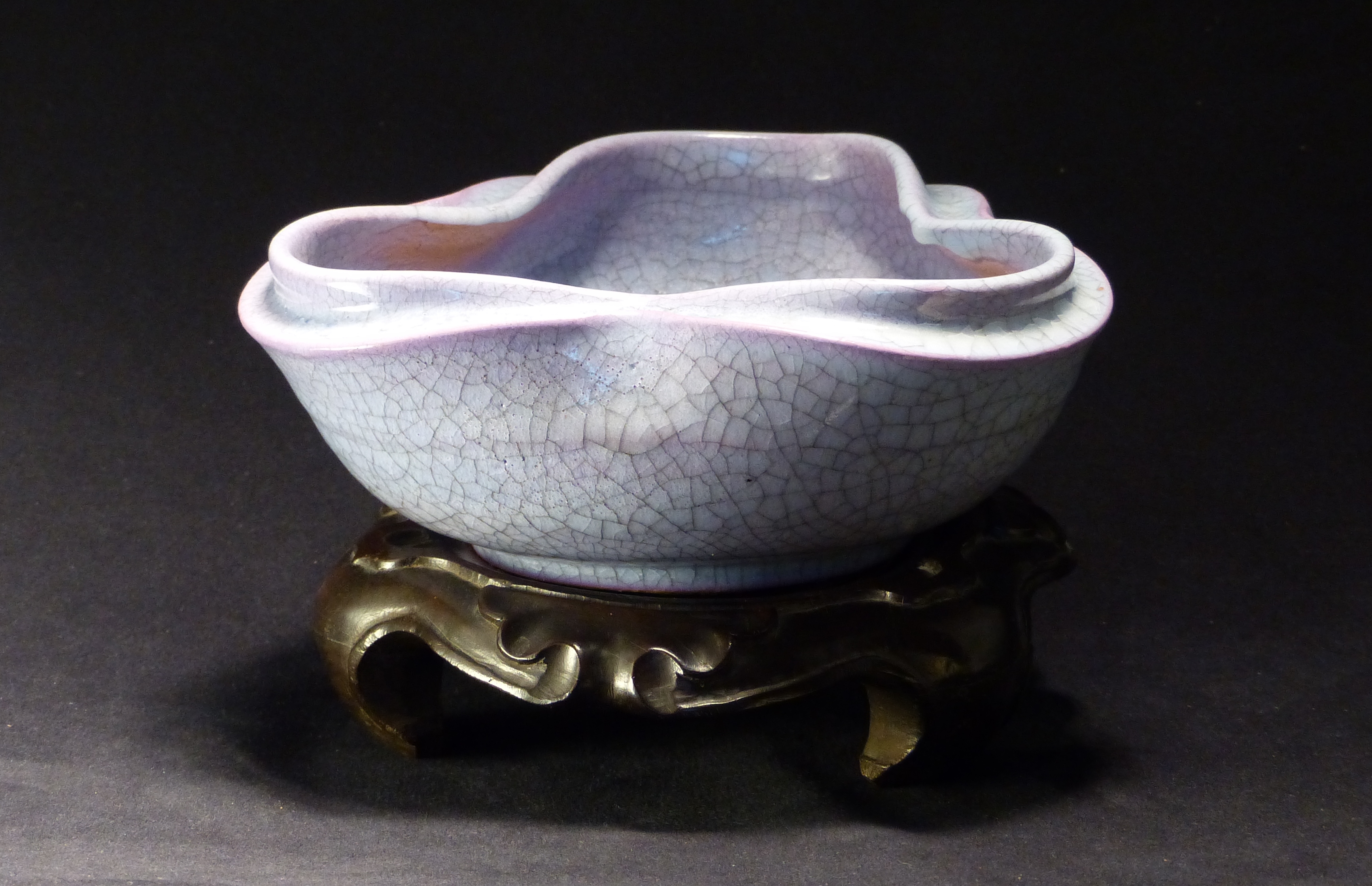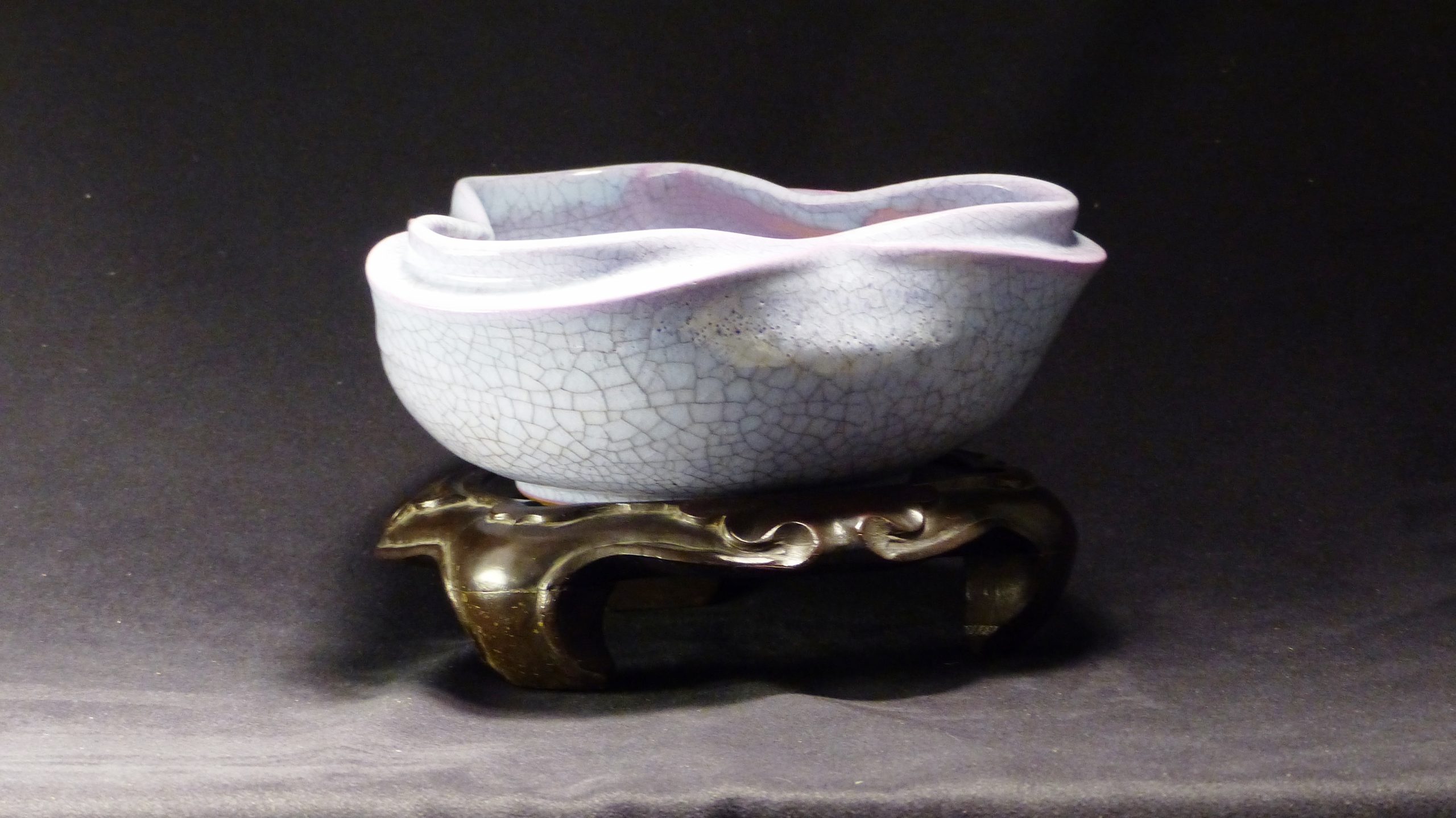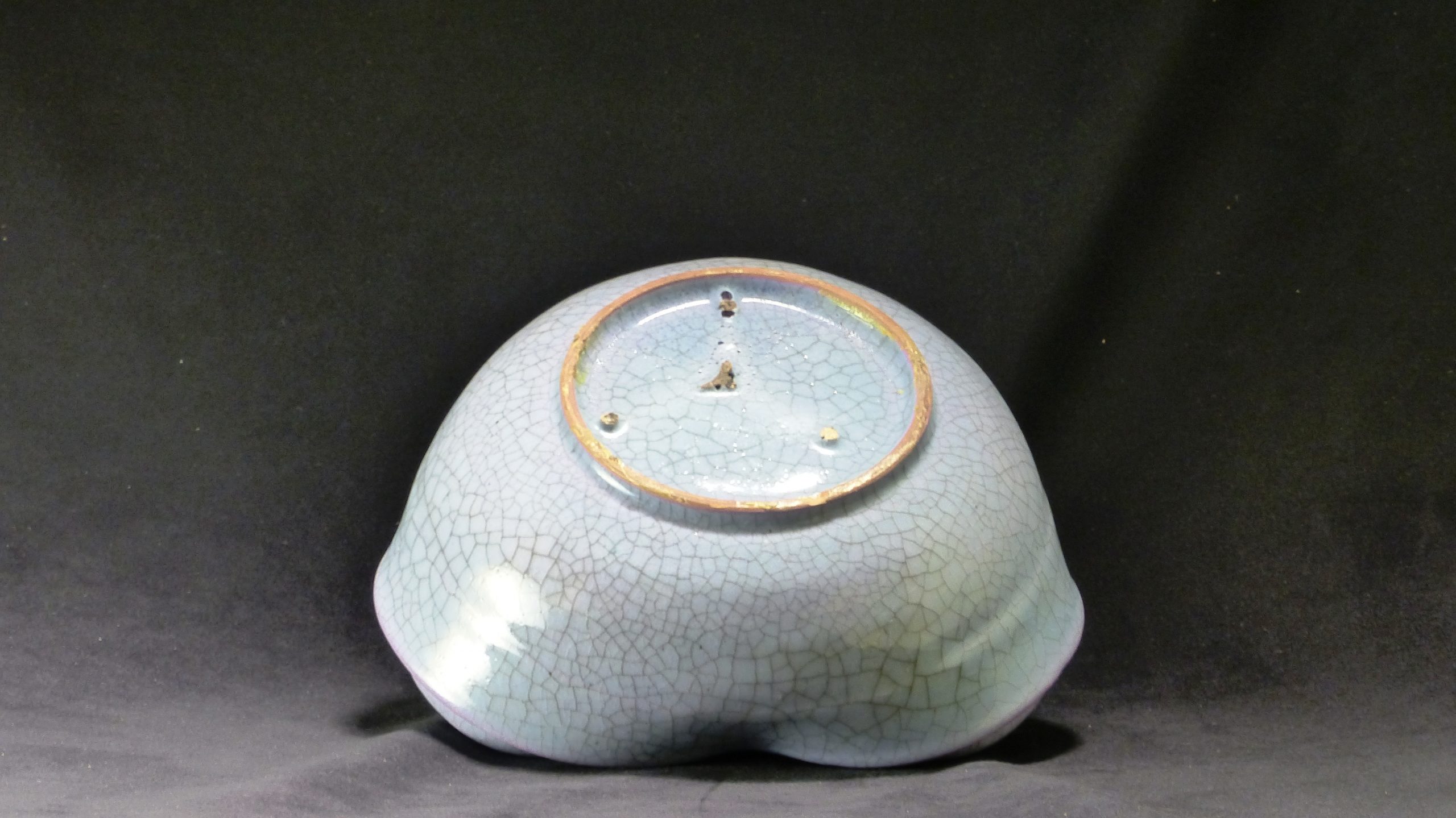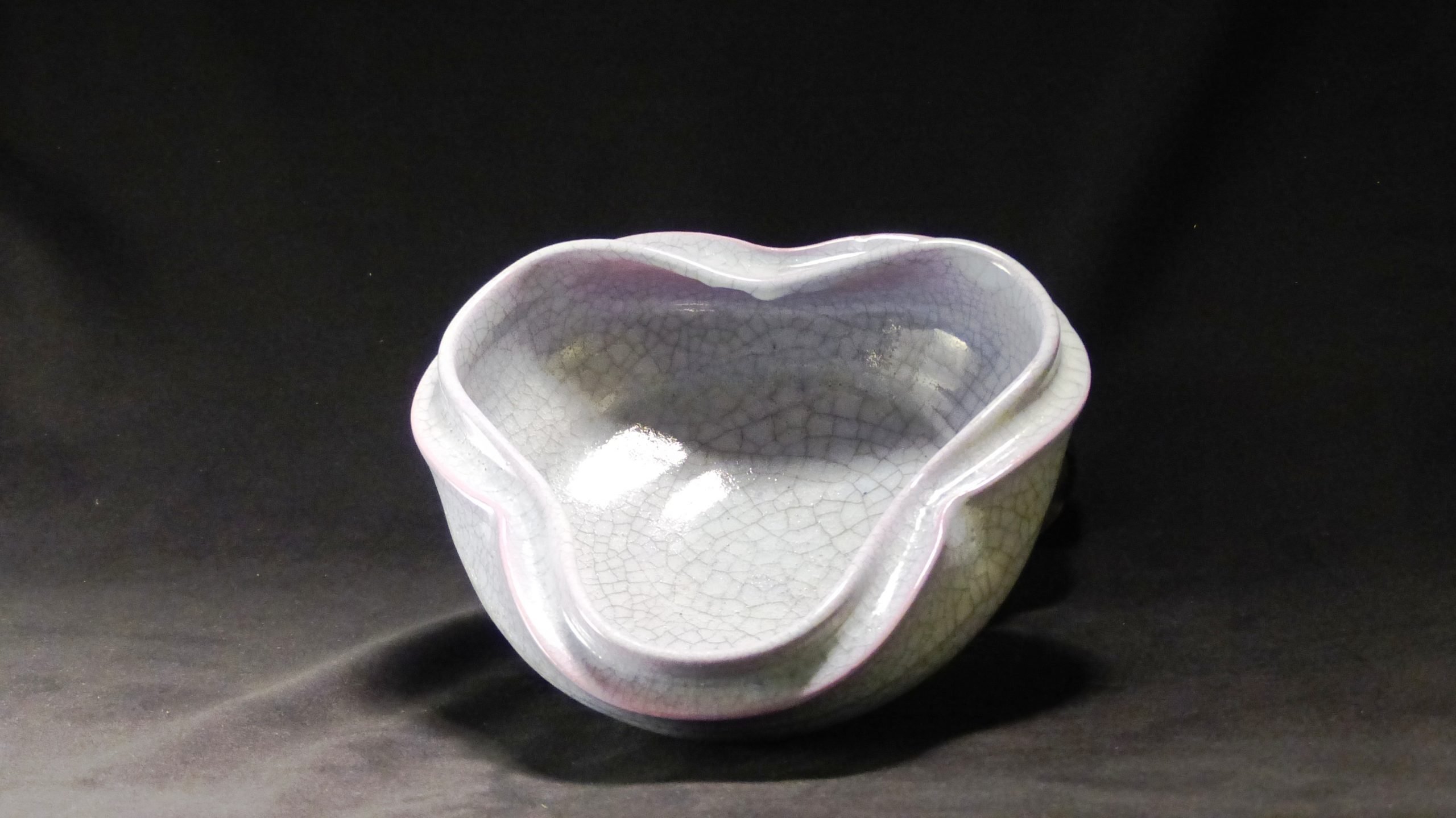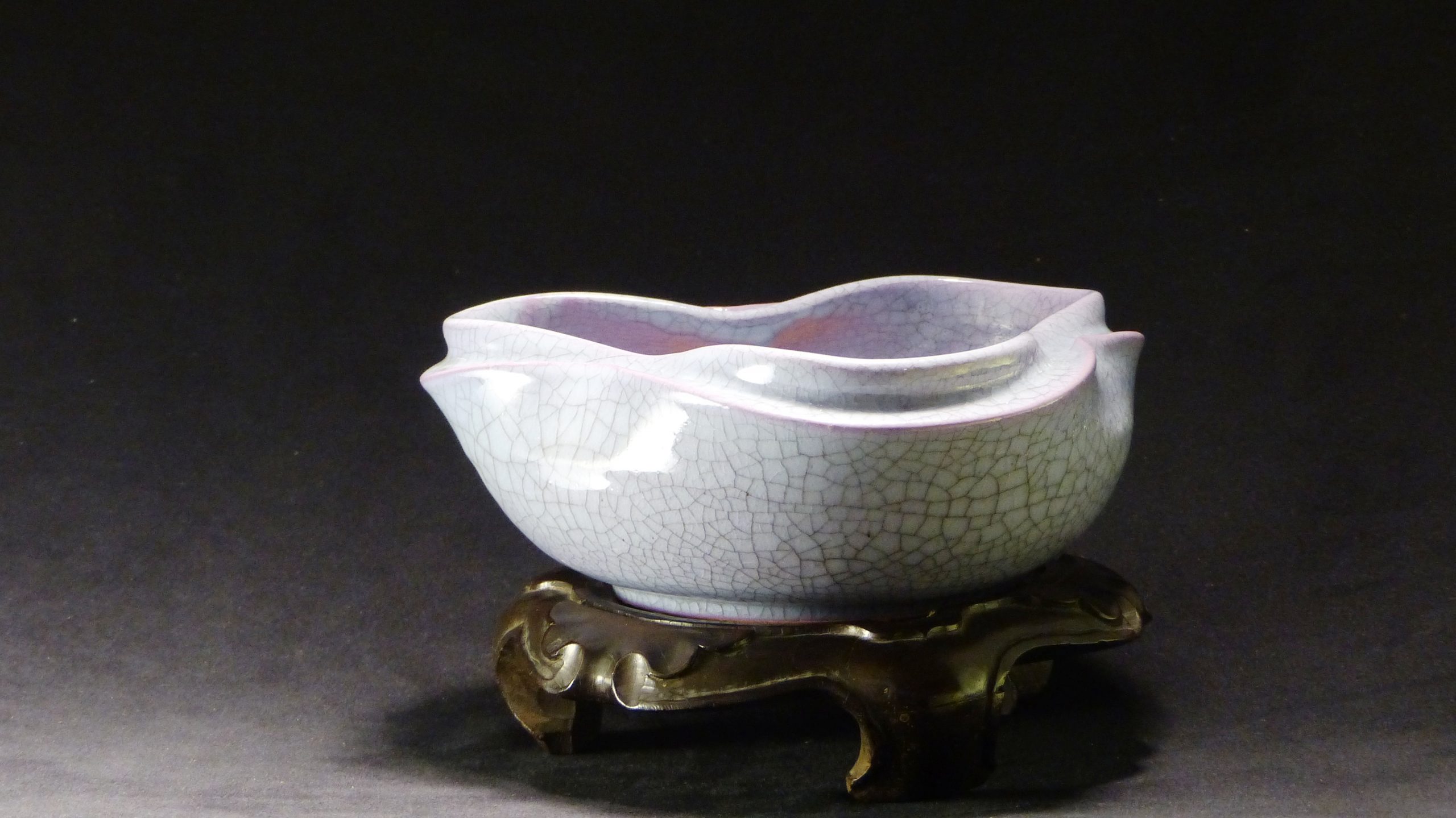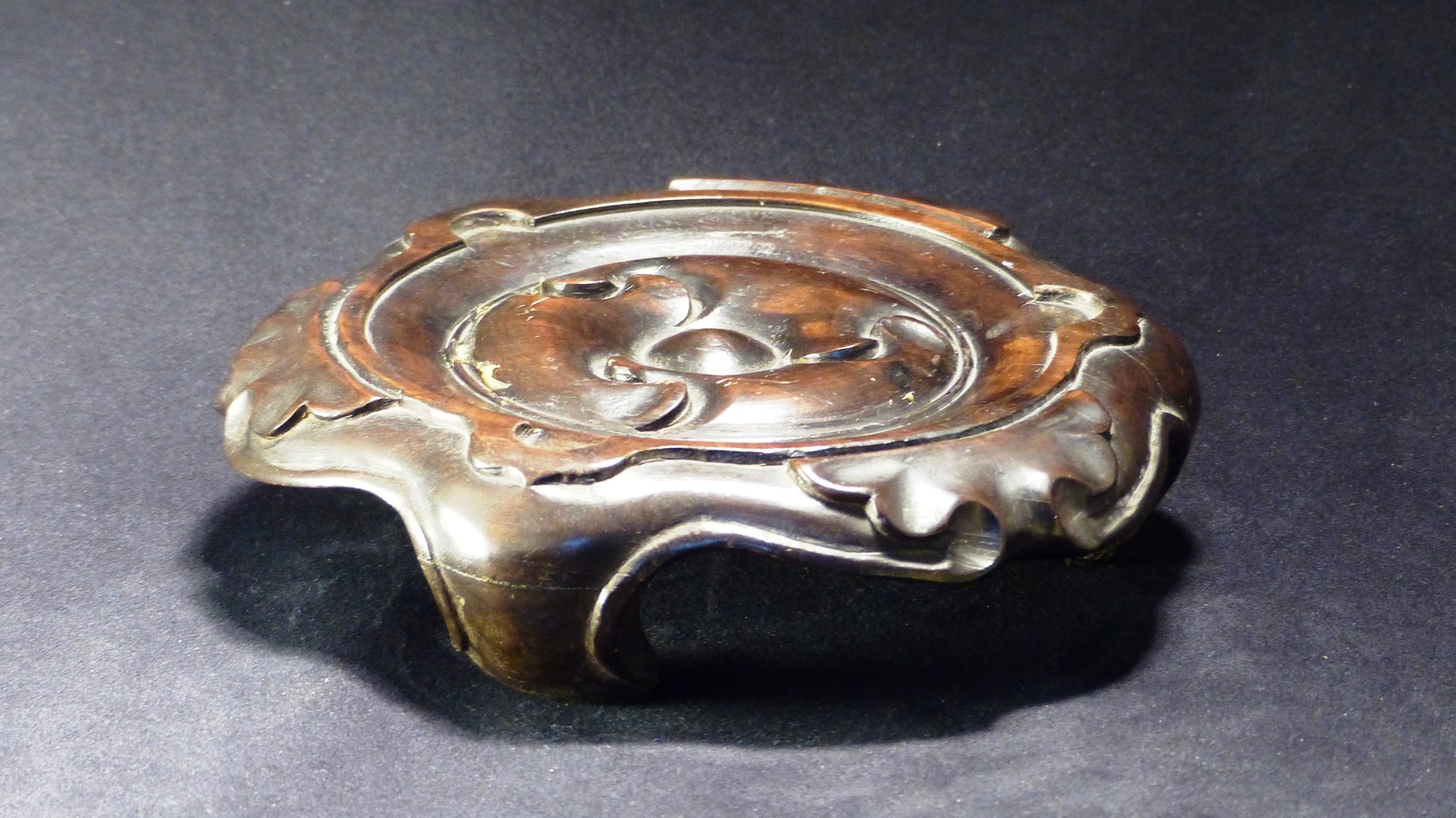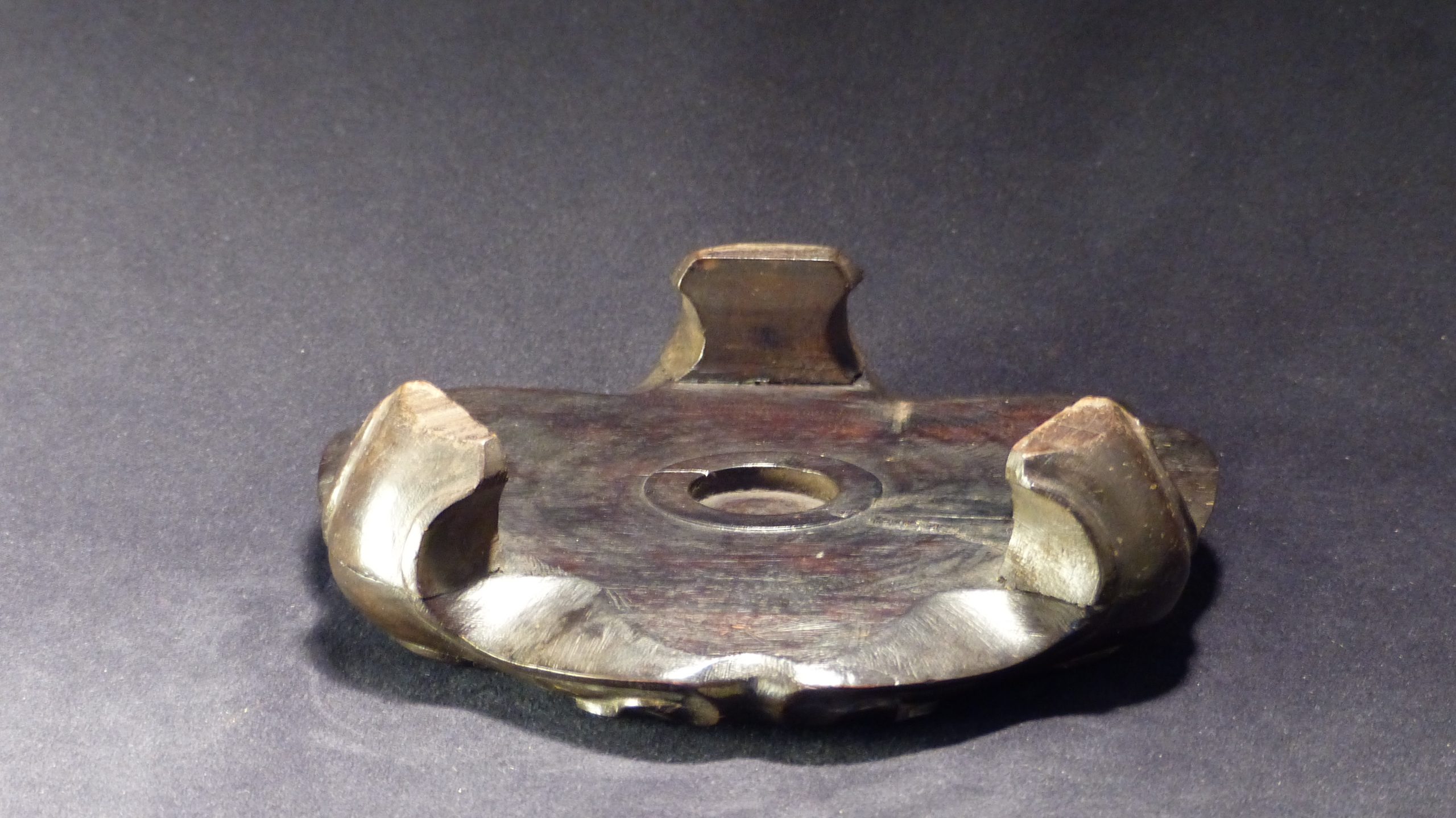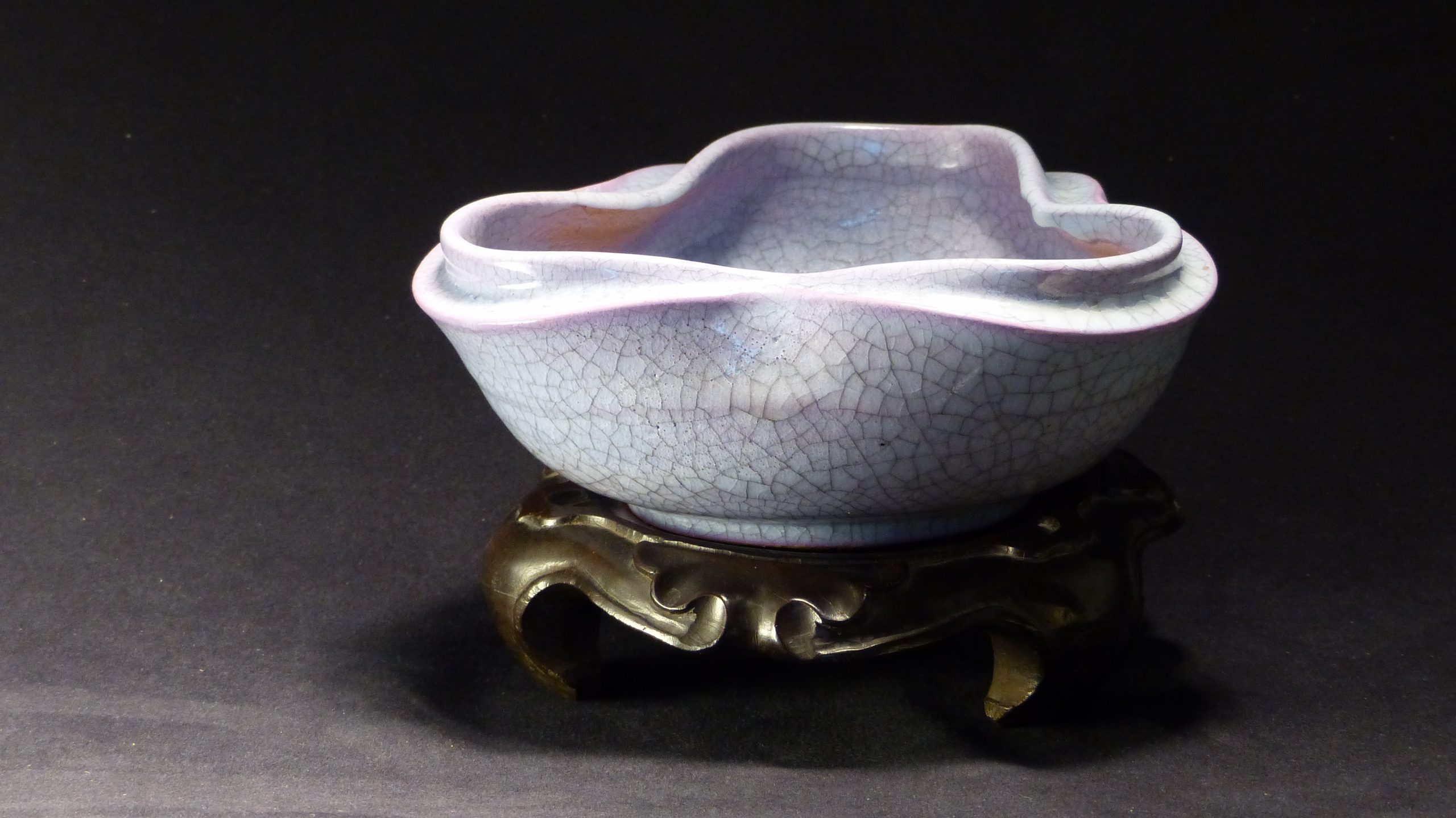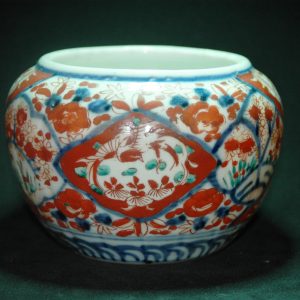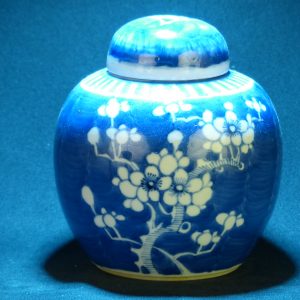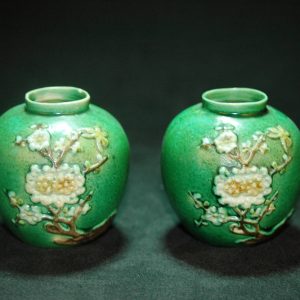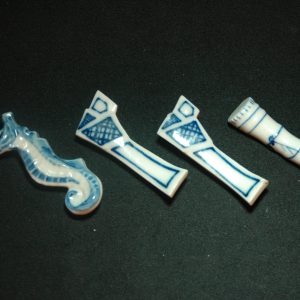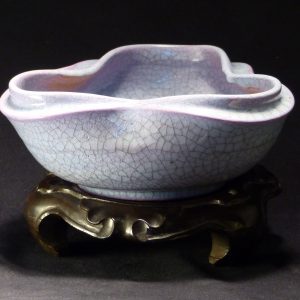Description
宋汝窑 三支丁烧天青色开片折边玉兰形水洗
参考:大英博物馆
Department Asia
Museum number 936,1012.82
清 钧窑荷叶碗 喬治・尤莫弗普勒斯旧藏
Qing dynasty JunWare glazed lotus leaf Bowl 18thC,China
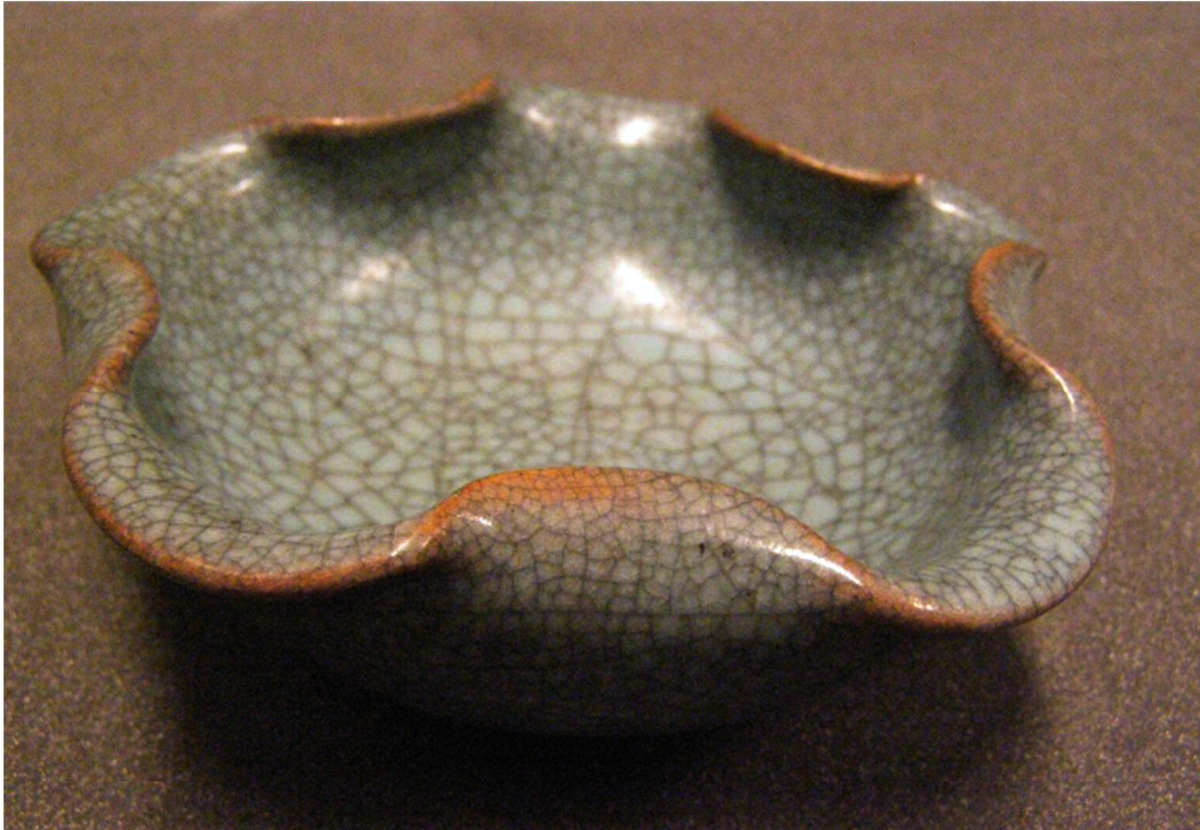
Description
Bowl. In the form of a lotus leaf. Made of Jun glazed crackled
Diameter: Diameter: 4 inches
Purchased from: George Eumorfopoulos
Acquisition date 1936
参考: 故宫博物院【广窑荷叶式洗】

广窑荷叶式洗,清,高4厘米,口径10.4厘米。
洗作荷叶舒卷式,卷沿深腹,造型别致。其胎体厚实,器身施天青釉,釉色莹润,通体开片,且纹片大小不一,纹理自然,体现了文房用具的清新雅致,别具情趣。
撰稿人:张林杰
关键词: 广窑 青釉 开片
參考: 故宫博物院【定窑白釉荷叶式盏托】



定窑白釉荷叶式盏托,北宋,高2.6厘米,口径13.9厘米,足径5.5厘米。故宫博物院藏。
盏托呈卷曲的嫩荷叶式。口边五曲凹进,浅腹,边沿宽大,圈足。通体里外施白釉。
瓷盏托在宋代很常见,汝窑、定窑、钧窑、耀州窑、当阳峪窑、景德镇窑等均有烧造,品种有白釉、酱釉、青釉、汝釉、官釉、钧釉、青白釉等。
撰稿人:李卫东
关键词: 定窑 盏托 汝窑 钧窑 耀州窑 当阳峪窑 景德镇 青釉 青白釉
参考:苏富比 312
中國藝術品
香港私人舊藏
明或更早 哥窰葵瓣洗


80,000 — 120,000港幣
拍品已售 3,720,000 港幣 成交價 (含買家佣金)
拍品詳情
明或更早 哥窰葵瓣洗
10.2 公分, 4 英寸
狀況報告
整體品相良好,惟有兩道毛細沖線(較長者約2.5公分,自口沿向內壁延伸,形狀不規則)及口沿一處輕淺剝釉。帶典型窰燒瑕疵,如棕眼。
來源
趙從衍(1912-1999年)收藏
中國藝術品
2018年11月29日 – 2018年11月30日 | 上午 10:15 HKT
香港
参考:苏富比 5
俊雅清凝 — 樂從堂藏宋瓷粹珍
PROPERTY FROM THE LE CONG TANG COLLECTION
北宋 汝窰天青釉洗







估價待詢
拍品已售 294,287,500 港幣 成交價 (含買家佣金)
拍品詳情
北宋 汝窰天青釉洗
finely potted with shallow rounded sides rising from a slightly splayed foot, exquisitely veiled in a luminous and translucent bluish-green glaze suffused with a dense network of glistening ice crackles, the glaze thinning at the extremities to subtly reveal the body beneath and pooling particularly along the cavetto and foot to an unctuous caesious colour, the underside with three delicate ‘sesame-seed’ spur marks
13 公分,5 1/8 英寸
狀況報告
品相幾乎完美,唯口沿一道約1 公分不顯眼細沖及一處細小剝釉。
來源
倫敦蘇富比1982年6月15日,編號252
鴻禧美術館收藏,台北
展覽
《清翫雅集廿週年慶收藏展:器物》,台北,2012年,編號24
出版
史彬士(編纂),《中國歷代陶瓷選集》,鴻禧美術館,台北,1990年,編號40
相關資料
冰裂瑩翠-汝官窰筆洗
康蕊君
北宋晚期御瓷汝官窰,造於河南汝州,今寶豐縣,近千年來地位至高,實為神品,乃中國歷史之珍,顯中國哲學之華,集中國美學之粹。汝瓷小巧樸雅,溫婉雋永,不僅代表中國陶瓷藝術之真髓,歷史意義更是深遠,古今名藏均以其為首,然珍稀無比,一器難求。
此件汝官窰筆洗,釉如凝脂,天青猶翠,冰裂瑩澈,器形巧緻雅絕,底見三芝麻花細小支釘。為台北鴻禧美術館舊藏,通器完美臻善,當屬汝官瓷之範。
與南宋杭州官窰瓷相異,汝瓷特徵極為明確,然釉色仍有多樣變化,可見淡藍乳青無紋者,一如香港蘇富比2012年售出之葵花式洗(見以下名錄編號29),亦有瑩亮晶透,青翠泛藍,細披冰裂開片紋者,即如本品。早明曹昭《格古要論》尚前者無紋,南宋杭州官窰則似以後者為典範,二者均極為珍罕,兩造之間更見各式釉色變化,色有淡灰者、開片遍佈,或片紋染深,但釉面乳濁不透者。
無論物換星移,此件汝官窰筆洗臻美耀眼,仍屬傳世汝瓷之最,釉色相近者如大維德基金會藏品(53)、羅斯卡博物館藏一對圓洗之一(57)及 Princessehof Keramiek 博物館藏例(59)。觀傳世汝瓷名錄可知,如此釉色僅能見於尺寸較小且造形素雅之器,而尺寸較大或器形繁複者,其釉色往往略偏,不若典型,一如大維德基金會藏知名長頸瓶,汪慶正因而曾質疑其汝窰身分(汪慶正等,1991年,頁116)。
逾九百載,歷經千秋萬代之珍愛細藏,此汝官窰筆洗方可保存得如此盡善完美。汝瓷稀若晨星,據傳世名錄可見,汝窰從未大規模燒製,同一器形往往僅見一、二例,造形簡素者,則尺寸各異,底作三或五顆支釘等。例如存世五件瓶器(編號1-5),僅有二瓶造形一致;六件水仙盆(編號6-11),可至少分類為二種尺寸;三件香爐之一(編號14),遠較另二器(編號12-13)為大;三十三件筆洗(編號30-62),器形可見些微差異,尺寸自12.3公分至16.7公分不等,無統一規範。
異於南方龍泉地區可長達百米之龍窰,汝窰燒造於僅止兩米長之饅頭窰,不同於定瓷類節省空間之覆燒方法,汝瓷採立燒,且各器製於獨立匣缽中,更使空間侷促。窰匠小心翼翼於窰具上平衡泥坯,以三或五顆細小支釘支撐全器,困難重重,燒造成功者遂少。汝瓷多需二次入窰,先素燒,復釉燒。釉面開片紋乃出窰冷卻時,釉與胎身之收縮速度不同所致,起因偶然,卻成汝瓷特色。燒成如同天然寶石結晶般閃爍迷人之冰裂釉色,卻仍需天時地利,非人為可控制。
汝瓷引古思、憶史訓,輝映北宋徽宗一朝(1101-1125年在位)汴京之盛,藝詣文風至高;又讓人痛念南宋高宗(1127-1162年在位)遷都臨安,外患交迫,仍試圖於杭州再造大宋榮光。
學者相信官汝窰之燒造時間極短,普遍認為或只廿載,約於北宋哲宗(1086-1100年在位)至徽宗二朝之間。陳萬里專文(陳萬里,1951年)述應為1086年至1106年一說,廣得認同,但仍有少數學者持他論。雖無記載帝王直接命燒汝官瓷,史料有錄朝廷嫌河北定瓷口沿有芒,敕另設官局燒青瓷,窰建河南汝州,或開御瓷訂燒先例,棄前從各處貢瓷中擇佳之法。
汝瓷素雅不豔,含蓄實華,呼應宋人尚真、順應萬物之世界觀。如此品味為北宋思想家王安石(1021-1086年)所尚,布衣粗食,樸簡歸真,深切影響當時文人畫家,不同於畫院派華麗構圖與繁複技法,他們筆下線條簡約,描寫自然鄉野,樸拙而意趣橫生。一如宋時畫家繪山水重雲氤之美,瓷匠亦追求燒出「雨過天青色」,而唐代所尚如玉之濃翠綠。瓷雖非寶石黃金之貴,經過高溫窰燒而得的柔美釉色,偶然自來之晶亮冰裂,一切順應自然,樸實而綺麗,深深應合中國文人之德。宋人賞瓷,評其器形、釉料、色澤、觸感,彷彿早已預言簡約主義的到臨,不論是風格或技術,至今仍是藝人工匠們的靈感泉源。對雅瓷的追求,始於宋時文人墨客,未幾傳至內府,漸同此好。
女真南侵中原,北宋衰亡,汴京失守,遷都杭州臨安,汝窰定窰同告陷沒,內廷欠乏佳瓷,高宗遂於杭州新設官窰,依樣照造仿故汝。此件汝官窰筆洗之天青釉色及冰裂紋,即得南宋官窰致力摹傚(可比較國立故宮博物院藏品:台北,2016年,圖版II-2、II-7、II-11及12、II-42及43)。
紹興二十一年(1511年),宋高宗得重臣張俊奉進汝瓷十六件,如此重禮可知張氏權重顯赫,且忠心不二,得後人記載(《武林舊事》,通書記杭州舊事,周密著,1232-1308年)。北宋汝瓷只供御廷,僅有揀退之品出售,殊不可得,張氏何以能得十數汝瓷,且為可供御之質,仍未得解。
明人重汝,稱汝瓷底部支釘痕為「芝麻粒」,首見於萬曆十九年(1591年)高濂《遵生八箋》初刊。惜真品難得一見,乏汝瓷範本可依,儘管景德鎮窰擬燒各朝佳品,未見仿汝。唯一例外者為一件藍釉水仙盆,書宣德年款,乃景德鎮御窰依照畫中汝瓷而作(《明代宣德官窰菁華特展圖錄》,國立故宮博物院,台北,1998年,圖版36)。及至清雍正始仿汝瓷,世宗曾敕將各式汝器南送御窰,以便仿製燒造。雍正十年(1732年),御旨燒造瓷品清單,記「銅骨無紋汝釉,仿宋器貓食盤人面洗色澤」以及「銅骨魚子紋汝釉,仿內發宋器色澤」(Stephen W. Bushell,《Oriental Ceramic Art: Illustrated by Examples from the Collection of W.T. Walters》,紐約,1986年;重刊版,倫敦,1981年,頁194f)。雍正七年(1729年),內務府活計清檔列各式汝窰筆洗三十一件,或有銘文,珍存於可能來自日本之洋漆箱中(台北,2006年,頁25),記載為鐫有刻文者,皆與現存台北藏品吻合。雍正六年至七年間(1728-29年)繪製〈古玩圖〉二卷,其中描繪數件御藏汝瓷,如一件金屬釦口水仙盆(下列編號7,並見康蕊君,〈Art in the Yongzheng Period: Legacy of an Eccentric Art Lover〉,《Orientations》,2005年11/12月號,頁65右上),及大維德基金會藏一汝瓷盌(編號17,見《盛世華章》,英國皇家藝術學院,倫敦,編號168左下)。
乾隆帝對汝瓷賦詩詠嘆,且命宮中匠人鐫文於器,致使汝瓷名氣更勝從前。傳世汝瓷八十七件中,二十二件刻有其御題詩。高宗略欠明辨汝瓷之識,時有錯認,更曾誤將先父在位時仿汝器以為宋時真品,鐫詩詠贊(前述出處,編號197)。
1923年,滿清帝制(1644-1911年)已亡,紫禁城將開放為公眾博物館之前,用以典藏古物之建福宮發生大火,據傳為宮中太監為掩飾監守自盜之行而為,餘燼中僅存少數的汝瓷及明成化鬪彩雖遭祝融波及,仍未全毀,傳世八十七件汝瓷中,即有十五件曾為火損。在西方,直至1935-1936年,假倫敦英國皇家藝術學院舉行之《倫敦中國藝術國際展覽會》展示由中國政府借出汝瓷十件,才確知神秘佳器之貌,然少數汝瓷已在此之前納入西方典藏,其中大維德爵士與 George Eumorfopoulos 珍藏汝器均共列此展。大維德爵士因策展而能近距離賞鑑汝瓷,深入研究其歷史背景,展覽結束後更於《東方陶瓷學會彙刊》撰文〈Commentary on Ju Ware〉(大維德,1936-1937年)。
多年來,人們屢尋汝窰遺址不果,直到1986年,才發現河南寶豐清涼寺汝官窰址,並出土大量汝官窰器殘片。據出土瓷片,寶豐窰也有燒製民用瓷器。傳世汝窰器一般小巧淡素,但考古發掘顯示,汝窰藝匠敢於創新,挑戰複雜立體形狀、鏤空、劃花等設計,惜似乎未有標新創異之全器流傳窰外。近年發現多個窰址,雖有說或為北宋官窰,尤河南汝州清涼寺附近之張公巷(北京,2009年),其出土瓷片卻與傳世汝器有別。
__________________________________________
傳世汝官瓷通考
康蕊君
宋瓷類種琳瑯萬象,以汝瓷最是稀貴,位中國陶瓷之首,存世之例寥如晨星,可羅列數之,究因有二:一者,自古汝瓷極得珍視,代代遞藏,雖偶有遺珠之例,然私人收藏中幾無可能再現未錄之器;其二,後世未見近類汝瓷之作,同朝民窰亦無造出相近者,異於南宋杭州官窰瓷一類,存世汝官瓷明確可辨,不受魚目混珠之累。
中國陶瓷史中,唯一亦可羅列清冊者乃明代成化窰官瓷,朱湯生曾造冊載之。存世汝官瓷未及百件,相較之下,成化官瓷數量卻高達六倍以上。
多位學者均曾清點存世汝官窰數目,歷經數十載,名冊數目略見增加。1958年,G.St.G.M. Gompertz 編列初三十一件海外藏汝瓷,此外中國政府曾送展十件參加1935/6年的倫敦展覽(Gompertz,1958年,頁34)。當時中國境內收藏之例,未見有錄,自此著錄陸續可見新例,尤以舊藏於中國者為多,偶有海外藏瓷。Gompertz 清單所列部分品名,如今雖不再認定為汝官窰瓷,其總數卻極為接近現今普遍認可之汝瓷數量,三十六件。1987年汪慶正等出版統計全世界共計六十五件官汝窰器,並隨後於1991年出版更新為六十九件,然其中包含數例作者亦存疑之器(汪慶正等,1987年,頁38-40;1991年,頁115-117)。
2009年大阪市立東洋陶瓷美術館汝窰青磁特別展圖錄中,出川哲朗羅列七十例(大阪,2009年,頁279-87)。香港蘇富比2012年汝窰天青釉葵花洗圖錄中,我們另在此名冊的基礎上補充九件傳世汝官瓷,這些均乃傳世之器,即經代代相傳,未曾入土(蘇富比,2012年,頁40-43)。
北京故宮博物院近期出版專著(北京,2015年,頁260-305),以上列著錄為基礎,增添多件館藏汝瓷,其中多數於1923年大火中受損,因而早年未曾著錄出版。此名單共錄全球九十件汝瓷,但其中四例應可剔除:北京故宮2001年購藏之一件鸚鵡形殘片(北京,2015年,圖41);一件採集自寶豐清涼寺後捐贈予上海博物館之筆洗,該洗為汝官窰遺址地點提供了重要的線索,促成了後來的發掘(北京,2015年,圖42);廣東省博物館藏一件淺盤,乃破片重建而來(北京,2015年,圖54);還有一件盞托,著錄為高麗青磁,而非汝瓷(香港嘉德2013年4月5日,編號414;北京,2015年,圖90)。
雖然辨別傳世或是出土不易,於此筆者欲暫且剔除另外四例,因未能確認其為傳世之品:三件載錄於北京故宮名冊之筆洗(北京,2015年,圖34、56、59)以下編為(88)、(89)、(90);以及一件近年現身日本之小盃,編號(91)。還有一件筆洗,曾於1922年出版,亦不列於此,見編號(92)。
另有四件汝瓷,其身份已得廣泛認同,但未錄於北京故宮之名冊,遂補上:一為近判定為汝瓷之辛辛那提藝術博物館藏三足爐,編號14;二為荷蘭及丹麥博物館藏汝窰筆洗,如下編號59、60;另一為上海博物館藏汝瓷盤,編號68 - 總結共八十七件。
1986年,河南寶豐清涼寺發現北宋汝官窰遺址,出土大量汝官瓷殘片,然汝官窰器原為宮廷所造,此類因燒造瑕疵而留於原址,及未成品(例如,未施釉之素坯器),不列入此名單。
1940年以來,僅有六件汝官瓷經由拍賣售出:
汝窰長頸賞瓶,Eumorfopoulos 舊藏,現屬倫敦大英博物館大維德基金會藏品,售於倫敦蘇富比1940年5月28日,編號135。
汝窰水仙盆,口沿釦飾金屬,屬安宅氏舊藏,現存大阪市立東洋陶瓷美術館(編號10),曾二度於倫敦蘇富比售出,首為1959年3月17日,編號26,後為1970年2月24日,編號1。
汝窰圓筆洗,屬羅桂祥基金會舊藏,現存香港藝術館(編號51),曾售於倫敦蘇富比1980年4月15日,編號140。
汝窰盤,屬 Stephen Junkunc 三世舊藏,現為區百齡收藏(編號80),售於紐約佳士得1992年12月3日,編號276。
汝窰盤,經火燒,磨口,同屬 Stephen Junkunc 三世舊藏(編號69),售於紐約佳士得2006年3月29日,編號401。
汝窰葵花洗,為艾弗瑞.克拉克伉儷舊藏,現屬私人收藏(編號29),售於香港蘇富比2012年4月4日,編號101(圖一)。
下列八十七件傳世汝官瓷,幾乎皆為博物館典藏,僅餘四件仍屬於私人珍藏(圖一)。
現存傳世汝官窰器名錄
S編號乃北京故宮專著《汝瓷雅集》書後之附錄號碼,北京,2015年,頁260-305
[] 仍存私人收藏之傳世汝官窰器
瓶器,折肩,臥足(2)
1 台北國立故宮博物院,清宮舊藏:22.4公分,金屬釦口,銘「奉華」及乾隆皇帝御製詩(S 1)
2 台北國立故宮博物院,清宮舊藏:20.5公分,口沿磨平,底心一長方面刮去釉層,銘乾隆皇帝御製詩(S 2)
瓶器,圓腹(1)
3 倫敦大維德爵士典藏,Eumorfopoulos 舊藏:24.8公分,金屬釦口(S 60)
瓶器,卵圓腹(1)
4 台北國立故宮博物院,清宮舊藏:17.9公分,截口,金屬釦口及圈足,底心一圓面刮去釉層,銘乾隆皇帝御製詩(S 3)
瓶器,膽形(1)
5 倫敦大英博物館,艾弗瑞.克拉克舊藏:20.1公分(S 72)
「水仙盆」(6)
6 台北國立故宮博物院,清宮舊藏:23公分,銘乾隆皇帝御製詩(S 4)
7 台北國立故宮博物院,清宮舊藏:23公分,金屬釦口,銘乾隆皇帝御製詩(S 5)
8 台北國立故宮博物院,清宮舊藏:23.1公分(S 7)
9 台北國立故宮博物院,清宮舊藏:26.4公分,磨足,銘乾隆皇帝御製詩(S 6)
10大阪東洋陶瓷美術館,安宅氏舊藏:22公分,金屬釦口(S 83)
11 吉林省博物館:23.2公分,截口,金屬釦口(S 53)
三足爐(3)
12 倫敦大維德爵士典藏:24.8公分(S 61)
13 北京故宮博物院,清宮舊藏:18公分(S 61)
14 辛辛那提藝術博物館:17.8公分
(Ellen B. Avril,《Chinese Art in the Cincinnati Art Museum》,辛辛那提,1997年,圖版63)
溫盌(1)
15 台北國立故宮博物院,清宮舊藏:16.2公分(S 8)
盌(2)
16 北京故宮博物院,清宮舊藏:17.1公分,銘乾隆皇帝御製詩(S 24)
17 倫敦大維德爵士典藏:17公分,金屬釦口,銘乾隆皇帝御製詩(S 63)
盞托,葵口(2)
18 倫敦大英博物館,加納爵士舊藏:16.5公分(S 73)
19 倫敦大維德爵士典藏:17公分(S 62)
盞托,圓口(1)
20倫敦維多利亞與艾伯特博物館,加納爵士舊藏:16.5公分,金屬釦口,銘宮殿名(S 77)
盞托,平底(1)
21 波士頓美術館,John Gardner Coolidge 舊藏:18.7公分,(S 82)
三足承盤(1)
22 北京故宮博物院,清宮舊藏:18.3公分,銘乾隆皇帝御製詩(S 23)
大盌(2)
23 台北國立故宮博物院,清宮舊藏:15.9公分,金屬釦口佚失(S 16)
24北京國家博物館,故宮博物院借展:13.7公分(S 35)
筆洗,橢圓形,雙魚紋飾(3)
25 台北國立故宮博物院,清宮舊藏:14.2公分(S 9)
26 倫敦大維德基金會:14.2公分(S 64)
27 倫敦大維德基金會:14.5公分(S 65)
筆洗,葵口(2)
28 倫敦大英博物館,艾弗瑞.克拉克舊藏:13.6公分(S 74)
[29] 香港蘇富比2012年4月4日,艾弗瑞.克拉克舊藏:13.5公分(S 89)
筆洗,圓口(33)
30 北京故宮博物院,清宮舊藏:13公分,銘「乙」(S 25)
31 北京故宮博物院,清宮舊藏:12.9公分,金屬釦口,銘「乙」(S 26)
32 北京故宮博物院:13.6公分,銘「乙」,曾受火損(S 27)
33 北京故宮博物院:13.4公分,銘「乙」,曾受火損(S 28)
34 北京故宮博物院:13.5公分,銘「乙」,曾受火損(S 29)
35 北京故宮博物院:13.9公分,銘「乙」,曾受火損(S 30)
36 北京故宮博物院:12.8公分,銘「丙」,曾受火損(S 31)
37 北京故宮博物院:12.8公分,銘「丙」,銘乾隆皇帝御製詩,曾受火損(S 32)
38 北京故宮博物院:12.8公分,銘「丙」,銘乾隆皇帝御製詩,曾受火損(S 33)
39 台北國立故宮博物院,清宮舊藏:14.9公分,銘「甲」(S 10)
40 台北國立故宮博物院,清宮舊藏:14.8公分,銘「甲」及乾隆皇帝御製詩(S 11)
41 台北國立故宮博物院,清宮舊藏:13公分,銘「丙」及乾隆皇帝御製詩(S 12)
42 台北國立故宮博物院,清宮舊藏:13.1公分,銘乾隆皇帝御製詩(S 13)
43 台北國立故宮博物院,清宮舊藏:12.9公分,銘乾隆皇帝御製詩(S 14)
44 台北國立故宮博物院,清宮舊藏:13.4公分,金屬釦口(S 15)
45 北京中國國家博物館:16.7公分,金屬釦口,或曾受火損(S 51)
46 上海博物館:13.5公分,曾受火損(S 43)
47 上海博物館:12.6公分(S 44)
48 上海博物館:12.6公分(S 45)
49 上海博物館:12.3公分(S 46)
[50] 此拍品,台北鴻禧美術館舊藏:13公分(S 58)
51 香港藝術館,羅桂祥舊藏:13.5公分,曾銘乾隆皇帝御製詩,但已磨(S 55)
52 倫敦大維德爵士典藏:13.7公分,銘「乙」,曾受火損(S 66)
53 倫敦大維德爵士典藏:13公分(S 67)
54 倫敦大維德爵士典藏:12.9公分(S 68)
55 牛津艾許默林博物館,艾倫巴羅爵士舊藏:12.8公分(S 78)
56 瑞典哥德堡羅斯卡博物館:13公分(S 85)
57 瑞典哥德堡羅斯卡博物館:12.9公分(S 86)
58 蘇黎世雷特柏格博物館,玫茵堂典藏:12.8公分,金屬釦口,銘「丙」(S 87)
59 荷蘭呂伐登 Princessehof Keramiek 博物館,Nanne Ottema 舊藏:13公分
(http://friesmuseum.delving.org/thumbnail/friesmuseum/princessehof/GMP%201981-111%20[01]/500)
60 丹麥哥本哈根藝術與設計博物館,A. Oigaard 舊藏:13公分(喜仁龍,《Kinas Konst under Tre Årtusenden》,斯德哥爾摩,1943年,卷2,圖324)
61 費城藝術博物館,William Crozier 少將舊藏:13公分(S 80)
62 克里夫蘭藝術博物館:12.9公分(S 81)
盤,深壁,圓口(7)
63 北京故宮博物院,清宮舊藏:18.4公分(S 38)
64 台北國立故宮博物院,清宮舊藏:15.8公分,銘「甲」及乾隆皇帝御製詩(S 17)
65 台北國立故宮博物院,清宮舊藏:21.4公分,圈足鑲釦,銘乾隆皇帝御製詩(S 18)
66 台北國立故宮博物院,清宮舊藏:18.4公分,銘乾隆皇帝御製詩(S 19)
67 倫敦大英博物館,George Eumorfopoulos 舊藏:19.6公分,銘乾隆皇帝御製詩,曾受火損(S 75)
68 上海博物館:12.3公分(汪慶正等,1987年,圖版32;1991年,圖版32及封面)
[69] 紐約佳士得2006年3月29日,Stephen Junkunc 三世舊藏:17.5公分,口沿略磨,曾受火損(S 88)
盤,深壁,侈口(3)
70 北京故宮博物院,清宮舊藏:19.3公分,銘宮殿名(S 36)
71 北京故宮博物院,清宮舊藏:19.6公分,銘「蔡」(S 37)
72 倫敦大維德爵士典藏:19.5公分,銘乾隆皇帝御製詩,曾受火損(S 70)
盤,淺壁,侈口(12)
73 北京故宮博物院,清宮舊藏:17.1公分(S 39)
74 北京故宮博物院,清宮舊藏:16.9公分(S 40)
75 上海博物館:17.1公分(S 47)
76 上海博物館:17公分(S 48)
77 上海博物館:17公分(S 49)
78 上海博物館:17公分(S 50)
79 天津博物館:17.2公分(S 52)
[80] 紐約佳士得1982年12月3日,區百齡典藏,Stephen Junkunc 三世舊藏:17.5公分(S 57)
81 倫敦大維德爵士典藏:17公分(S 71)
82 倫敦大英博物館,George Eumorfopoulos 舊藏:18.4公分,銘乾隆皇帝御製詩,曾受火損(S 76)
83 聖路易斯藝術博物館,Samuel C. Davis 舊藏:17.2公分(S 79)
84 東京國立博物館,川端康成舊藏:17.1公分(S 84)
盤,圓口,無足(3)
85 台北國立故宮博物院,清宮舊藏:12.8公分,金屬釦口,銘「奉華」(S 20)
86 台北國立故宮博物院,清宮舊藏:10.9公分,銘「丙」、「蔡」(S 21)
87 倫敦大維德爵士典藏:12.1公分,曾受火損(S 69)
或能入冊之器
未確認是否傳世品
(88) 筆洗,北京故宮博物院,贈於1965年:13公分(S 34)
(89) 筆洗,沐文堂典藏:13.9公分(S 56)
(90) 筆洗,觀復博物館:尺寸未知(S 59)
(91) 盃,日本私人收藏:10.2公分,經修復(《宋磁の美》,東洋陶瓷美術館,大阪,2016年,編號1)
現址未知
(92)筆洗,著錄載為高麗青瓷,或為汝瓷 :13公分(Oscar Rücker-Embden,《Chinesische Frühkeramik》,萊比錫,1922年,圖版43a)
_______________________________________
汝官窰參考書目舉要
大維德爵士,〈A Commentary on Ju Ware〉,《東方陶瓷學會彙刊》,卷14, 1936-1937年,頁18-69
陳萬里,〈汝窰之我見〉,《文物參考資料》,1951年,編號2
《Ju and Kuan Wares. Imperial wares of the Sung Dynasty, Related Wares and Derivatives of Later Date》,東方陶瓷學會,倫敦,1952年
G.St.G.M. Gompertz,《Chinese Celadon Wares》,倫敦,1958年
汪慶正、范冬青及周麗麗,《汝窰的發現》,上海,1987年,英文修訂版,香港,1991年
趙青雲等,《汝窰的新發現》,北京,1991年
葉喆民及葉佩蘭編,《汝窰聚珍》,北京,2001年
趙青雲編,《宋代汝窰》,鄭州,2003年
林柏亭編,《大觀-北宋汝窰特展》,國立故宮博物院,台北,2006年
《寶豐清涼寺汝窰》,鄭州,2008年
《汝窰與張公巷窰出土瓷器》,北京,2009年
《北宋汝窰青磁-考古発掘成果展》,東洋陶瓷美術館,大阪,2009年
康蕊君,《天青寶色-日本珍藏北宋汝瓷》,蘇富比,香港,2012年
《汝瓷雅集-故宮博物院珍藏及出土汝窰瓷器薈萃》,故宮博物院,北京,2015年
余佩瑾,《貴似晨星:清宮傳世12至14世紀青瓷特展》,國立故宮博物院,台北,2016年

汝窰葵花洗(編號29)
艾弗瑞.克拉克舊藏
香港蘇富比2012年4月4日,編號101
俊雅清凝 — 樂從堂藏宋瓷粹珍
2017年10月3日 | 上午 10:20 HKT
香港
参考:苏富比 506
中國藝術品
明末至清初 青釉盤


20,000 — 30,000港幣
拍品已售 25,000 港幣 成交價 (含買家佣金)
拍品詳情
明末至清初 青釉盤
18.9 公分,7 1/2 英寸
狀況報告
來源
Alberto Giuganino (1887-1979年) 收藏,羅馬
前往
中國藝術品
2016年12月2日 | 上午 10:00 HKT
香港
参考: 北京保利2019秋季拍卖会 >宸趣——文房清玩隽品集珍
7146 清乾隆 仿汝釉弦纹洗

仿汝釉弦纹洗
拍品信息
LOT号 7146
作品名称 清乾隆 仿汝釉弦纹洗
作者 —
尺寸 直径16.5cm
创作年代 清乾隆
估价 2,000,000-3,000,000
成交价 RMB 4,600,000
「大清乾隆年制」款
备注
1.S.Marchant & Son, London伦敦马钱特父子商行;
2.The Rodriguez Collection;
3.胡惠春先生旧藏;
4.苏富比纽约,1985.6.4,Lot47;
5.佳士得纽约,2005.9.20,Lot291
此洗呈圆形,敞口,口沿和腹部仅以一条弦纹装饰,通身仿汝釉,釉色温润肃穆,釉质莹润肥厚,开片疏朗有致,予人以清新自然之感。器形端朴稳庄,典雅可嘉,为清乾隆期宫廷官器仿汝釉之成功典范,点缀案头,美不胜收。底足内青花书「大清乾隆年制」六字三行篆书款,配有著名收藏家胡慧春先生亲选木制底座。
据《乾隆四年各作成做活计清档》:十一月十八日,七品首领萨木哈催总白世秀将唐英照样烧造得……酌量釉水烧造得笔洗水盛等样一百三十九件,持进交八品官高玉、太监毛团、胡世杰呈览,其余俱送圆明园内总管俟大运新磁器,到时一同挑选等次钦此。(于十二月初八日将烧得:鱼子纹汝釉笔洗六件、汝釉六方水盛二件、汝釉长方水盛二件……以上共一百四十二件俱交柏唐阿双住福保送赴圆明园讫。)其中所称「鱼子纹汝釉笔洗」应为拍品相同器。又据乾隆二十七年《各作成做活计清文件》中记载:「二十五日,郎中白世秀来说太监如意交汝釉圆洗一件(紫檀木座),传旨将座上如意云去了,其圆洗足往深里下稳,钦此」。应为拍品此类物之宫廷陈设状况。
汝瓷在北宋晚期宫廷中的使用时间极短,大约只有20年左右,汝窑器物也因此稀若晨星。根据故宫博物院的统计,汝釉传世品至今不过90件左右。汝窑瓷最早在南宋人叶置的《坦斋笔衡》中已称为诸窑之魁;另一位南宋人周辉在《清波杂志》中提到「汝窑……近尤难得。」到了明代的王世懋,其《窥天外乘》中说:「宋时窑器以汝州第一,而京师自置官窑次之。」除了釉色的品级外,汝釉还分有纹与无纹两个层次。明早期的曹昭在《格古要论》中说到「汝窑有蟹爪纹者真,无纹者尤好」。也就是说,曹昭认为不开片的汝釉要比开片纹的品级更高。常见开鱼子状细片纹的汝窑瓷,以台北故宫博物院藏的那件著名的莲花式温碗为代表;而不开片的汝窑则全世界仅有一件,那就是被誉为天下第一神器的台北故宫博物院藏无开片纹汝窑水仙盆,她完全呼应了明代大鉴赏家曹昭眼中「有蟹爪纹者真,无纹者尤好」的评语。这件绝无仅有的无纹汝窑水仙盆,不但釉色修洁绝美,而且品相完美。
景德镇仿宋汝窑器始自明宣德时期,但传世品极少。至清代,雍正皇帝、乾隆皇帝皆酷爱汝窑器,曾授意督陶官唐英仿制,《清宫造办处活计档》中记载着景德镇雍正六年(1728年)和乾隆三年(1738年)时仿汝窑器均多达40余件,此时应是清官窑仿汝的技艺与品质皆臻炉火纯青的化境,传世品所见,雍正窑仿汝器精纯无匹,难分彼此,而乾隆窑早期的仿汝器则不相伯仲,且款字笔法一致,显示皆为乾隆初年的作品,应全部出自唐英的亲自督造。通过仔细比较与调查,发现雍正窑与乾隆窑的仿汝釉器物,皆依循古人审定的品级,刻意烧制出有纹与无纹两种釉面效果。在宋时可能是某些偶然的原因所造成罕见的无纹釉色,如今皆可随心所意而成,足以见得雍乾官窑窑烧技法的精妙绝伦。如台北故宫博物院藏的一件北宋汝窑圆洗:
乾隆窑在仿烧这件北宋汝窑时,特意烧造了有纹与无纹两个版本,其中一件有纹的是北京故宫博物院藏一件开鱼子细纹的粉青釉仿汝弦纹圆洗,库号新39315,见图;另一件即为本例,来自著名收藏家胡惠春先生旧藏的一件无纹天蓝釉仿汝弦纹圆洗。这两件弦纹圆形制、规格完全一致,洗很明显皆是依照北宋旧藏母本精心仿烧而成,但别出心裁地在口沿下加了一道若有若无的弦纹,使整件器物在视觉上形成了一种典雅而新奇的感受,真可谓是匠心独运,仿古而不泥古,成就了清官窑自己的风格。
参考:Sotheby’s 蘇富比
2012年4月4日 | 上午 10:00 HKT | 香港
拍賣地點﹕
香港灣仔博覽道一號,香港會議展覽中心(新翼),展覽廳 5
101拍賣編號: HK0367 天青寶色──日本珍藏北宋汝瓷
AN OUTSTANDING RU GUANYAO LOBED BRUSH WASHER
NORTHERN SONG DYNASTY











成交總額
207,860,000港幣
成交總額 207,860,000港幣
簡介
汝官窯器向為帝君之傲、藏者之夢、藝匠之模,在中國歷史及藝術發展上舉足輕重。汝瓷小巧,樸而實綺,頌簡素之雅,順萬物之道,澤潤可愛、完美臻善之處;同時亦引古思、牽深情,憶北宋輝煌時期,造瓷技術之精,實別類所難及。宋朝以降,汝瓷稀若晨星,一器難求,而相關傳聞不絕,更為之披上神秘色彩。
汝官窯之燒造年期或只廿載,其器殊不易得,極為珍罕,至明之時,已有「絕難得」之歎。現今全球遺存之汝官窯瓷,有序可循者共僅七十九件,幾乎皆為博物館典藏。除本品外,僅餘六件仍屬私人收藏,此中三件為普通圓形水洗,三件為淺盤,其中一盤尺寸有損減。另外見有窯址出土物,但幾乎為廢棄之殘件破片。
觀乎當今私蓄汝官窯器,此可謂夢寐之品。論釉料,在私人收藏中,色質絶佳,妍壓群芳;論器形,罕作葵花六瓣,婉柔纖巧映玉色;論來源,艾弗瑞‧克拉克伉儷典藏舉世著名,在西方私人中國古物收藏界名列前茅,實為難得一見之珍品。
拍賣結果
北宋汝窰天青釉葵花洗,以 2 億 800 萬港元 / 2,670 萬美元成交,創宋瓷世界拍賣紀錄。
估價 60,000,000 — 80,000,000 港幣
拍品已售 207,860,000 港幣 成交價 (含買家佣金)
拍品詳情
AN OUTSTANDING RU GUANYAO LOBED BRUSH WASHER
NORTHERN SONG DYNASTY
THIS IS A PREMIUM LOT. CLIENTS WHO WISH TO BID ON PREMIUM LOTS MAY BE REQUESTED BY SOTHEBY’S TO COMPLETE THE PRE-REGISTRATION APPLICATION FORM AND TO DELIVER TO SOTHEBY’S A DEPOSIT OF HK$1,000,000, OR SUCH OTHER HIGHER AMOUNT AS MAY BE DETERMINED BY SOTHEBY’S, AND ANY FINANCIAL REFERENCES, GUARANTEES AND/OR SUCH OTHER SECURITY AS SOTHEBY’S MAY REQUIRE IN ITS ABSOLUTE DISCRETION AS SECURITY FOR THEIR BID. THE BIDnow ONLINE BIDDING SERVICE IS NOT AVAILABLE FOR PREMIUM LOTS.
overwhelmingly beautiful, finely potted with shallow rounded sides rising from a wide flat base raised on a slightly splayed foot, the thin walls divided into six evenly spaced lobes by small pinched notches each extending to a vertical groove, fully enveloped in a luscious caesious coloured glaze, a tactile delight, suffused with a latent crackle now and then accented with darker veins of cracklure, the glaze thinning at the extremities and along the lobes to a purplish colour and, at times, pulling gently to reveal the dark body beneath, conjuring the occasional beauty spot, the underside heightened with three delicate ‘sesame-seed’ spur marks, two Japanese paulownia wood boxes
13.5 cm., 5 1/4 in.
狀況報告
There are a few places on the rim with loss that have been filled in. There is a 1 cm triangular chip with an attendant 2.5 cm hairline on the rim with minor shallow filled fritting extending about 4 cm along the rim. This area has been covered with paint that has now yellowed (visible in the catalogue photo of the interior between 5 and 6 o’clock). In addition there are two other minor filled chips each no larger than 2 mm (at 11 and 3 o’clock). The chip at the 3 o’clock position has an attendant 2 cm hairline crack. The exterior has a 7 cm patch of slightly misfired glaze that has turned milky white. The glaze has two characteristic pinholes on the interior and a few minor glaze pulls around the foot on the exterior. There is diagram of the condition available upon request.
相關資料
Pride of Emperors, Desire of Connoisseurs, Model for Potters
Regina Krahl
Ru guanyao, the Ru kilns’ ‘official ware’, plays a role quite extraordinary in the history of China and her art. Hardly any other artefacts have elicited feelings as fervent as the small and deceptively modest Ru ceramics. Of outstanding rarity, historically connected to patriotic sentiments of a grand era, conceptually to philosophical ideals of life in tune with nature, and aesthetically to a sophisticated taste for artlessness and excellence, they have obtained an almost mythical aura.
The Northern Song court (960-1127) is recorded to have been unhappy about the white ceramics it received from the Ding kilns, apparently on account of the unglazed rims then characteristic of Ding wares. Thus it commissioned the kilns at Ruzhou, south of the capital, Kaifeng in Henan province, to produce celadons. The potters were ambitious, as they aimed to hide all evidence of the somewhat rough ceramic body by covering it all-over with luminous, mostly crackled glazes in various tones of a subtle blue-green. Fully enveloped in this glossy green coating the pieces almost looked as if carved from jade. To achieve this, they had to be precariously balanced in the kiln on pointed stilts. This technique of firing fully glazed vessels on small spurs rather than making them stand on an unglazed footring, was not invented by the Ru potters; it had been practised already at other manufactories before. The Ru kilns, however, perfected it by making the marks on the underside as tiny and tidy as possible and by reducing their number to the absolute minimum of three, thereby creating a distinctive characteristic for their wares. Already in 1591 Gao Lian flatteringly referred to the typical spur marks on Ru vessels as ‘sesame-seed’ markings.
Ceramics, as a non-precious material made valuable through craftsmanship perfectly accorded with the ideals of China’s elite at the time, of simplicity, modesty and naturalism. With their demanding criteria for judging proportion, glaze structure, tonal range and tactility, Song connoisseurs in many ways anticipated modern design movements, and Song ceramics still provide models of style and craftsmanship today. Although this taste was originally borne by the class of China’s educated scholar-officials, its sophistication did not remain unnoticed for long and the court soon fully embraced it. Ru official ware with its superficially simple aspect, whose focus is the overwhelming beauty of its glaze subtly set in scene by elegant, finely potted forms, embodies the quintessence of this taste.
Although the exact time of the production of Ru ware is still under debate, all scholars agree that it was made for an extremely short period only. Generally a space of some twenty years is proposed, from 1086 to 1106, although some scholars have argued for a slightly longer period. In any case, it was supplied to the court during only two reigns, those of the Emperors Zhezong (r. 1086-1100) and Huizong (r. 1101-25). We do not know yet in how far these emperors had any personal influence on its production. Zhezong ascended the throne as an infant and until 1093 power was de facto in the hands of the Empress Dowager Gao, neither of them known for a particular interest in fine works of art; Huizong on the other hand has gone down in history as one of China’s greatest imperial connoisseurs, patrons and collectors. This was the first time that the court had expressly ordered ceramics to be made for its own use – rather than picking the best of those supplied in tribute.
When in 1127 the Song lost the northern part of their glorious empire to the Jurchen and were forced to relocate the court to south China, they no longer had access to the official manufactory, which quickly declined to the level of a popular kiln. This lack of fine ceramics in the new capital, Hangzhou, must have served as a poignant reminder of this painful loss of territory and hegemony. As a quick return to the north became more and more unlikely, Emperor Gaozong (r. 1127-62), the first to rule out of Hangzhou in the south, in 1151 received a well-publicized gift of sixteen pieces of Ru ware from a high official, Zhang Jun – a symbolic patriotic gesture that clearly few individuals would have been able to match. Zhou Hui, writing on Ru ware in 1192 already said “… today it is very difficult to obtain”, Cao Zhao, writing in 1388, reported the same, “… examples are very difficult to obtain…”. In order to remedy this permanent shortage of wares of Ru quality, the Emperor set up new official kilns in Hangzhou to make ceramics especially for the court modelled on this coveted ware from the north that was reminiscent of happier days.
By the late Ming dynasty (1368-1644) Ru official ware was deemed completely ‘unobtainable’ or ‘to have ceased to exist’. Indeed its fame appears to have been based more on hearsay than on knowledge of actual items, with literary passages copying each other and by doing so, increasing the aura of this fabled product of the past. Its colour was said ‘to approach the blue of the sky after rain’, and agate was reputed to be mixed in the glaze. Although in the Song only selected pieces are supposed to have ended up at the court, whereas pieces rejected by the court were allowed to be sold, examples do not seem to have been available even to copy. In spite of its towering fame that surpassed that of the fabled guan and ge wares of the south, no copies of Ru were made in the Ming dynasty by the Jingdezhen porcelain kilns, which imitated anything of earlier periods that was deemed worthwhile, and certainly guan and ge.
It remained for the Yongzheng Emperor (r. 1723-35) in the Qing dynasty to revive the Ru style. An inventory of the seventh year of Yongzheng (1729) lists thirty-one Ru wares carefully kept in lacquer boxes, probably imported from Japan, all of them brush washers of various shapes and with various inscriptions (Lin Baiting, 2006, p. 25). Although we do not know for certain whether they had all been correctly identified, many of them are described as having inscriptions and can thus be matched to pieces extant in Taipei today. And these were not the only Ru vessels held in the palace storerooms. The Emperor sent originals of various types from the palace in Beijing to the porcelain kilns in south China to have them copied, or else to hold them up as standards of quality and stimulants for inspiration. In a list of different porcelains ordered to be made for the Emperor, preserved in the Jiangxi tongzhi [Annals of Jiangxi] of 1732, two types of Ru ware are recorded to be copied at Jingdezhen from Song originals: ‘Uncrackled Ru glaze with copper-coloured paste, copied from the colour of the glaze of two pieces of the Song dynasty’, and ‘Ru glaze with fish-roe crackle of copper-coloured paste, copied from the colours of the glaze of a piece of the Song dynasty sent from the imperial palace’ (Bushell, Oriental Ceramic Art: Illustrated by Examples from the Collection of W.T. Walters, New York, 1896; reprint London, 1981, pp. 194f.). Not only Ru copies were produced, however, but a whole range of vessels with various greenish glazes was inspired by Ru.
The Qianlong Emperor (r. 1736-95) contributed to the fame of the ware by composing poems on Ru and having them engraved on pieces from the imperial storerooms. At least twenty extant Ru pieces bear his inscriptions, although he did not always correctly identify them. Of eighteen different poems composed for Ru pieces, only two actually mention Ru ware. One of the Yongzheng Emperor’s copies even seems to have fooled his son, as the Qianlong Emperor had a lengthy poem inscribed on it, taking it for a Song original (China. The Three Emperors 1662 – 1795, Royal Academy of Arts, London, 2005, cat. no. 197). Yet the Song original sent by his father to Jingdezhen to be copied (fig. 1) must have been one of his favourites, too, since he had a special wooden stand made for it provided with a small drawer to hold a miniature album of his own paintings, calligraphies and seals.
In the West, the identity of Ru ware was long unknown. In 1915, when R.L. Hobson wrote his seminal work Chinese Pottery and Porcelain, he still stated (p. 52) “Though no authenticated example of Ju [Ru] ware is known in Europe, it is impossible to ignore a factory whose productions were unanimously acclaimed by Chinese writers as the cream of the Sung [Song] wares.” It was the International Exhibition of Chinese Art at the Royal Academy of Arts, London in 1935/6, which brought some enlightenment about this unknown ware as the Chinese Government had lent ten examples identified as Ru.
In China many attempts had been made to locate the kiln site, but it was only in 1986 that kilns considered to be the official Ru manufactories were identified at Qingliangsi, Baofeng, Henan province. A large number of sherds belonging to typical Ru official ware vessels were recovered. Remnants from the Baofeng kilns show that the potters also made ordinary, non-official wares, and that they were more ambitious than the extant items let one to believe. Whereas virtually all extant pieces of Ru official ware are small and plain, experiments were made with many complicated sculptural forms, openwork designs, and detailed engraved decoration, of which no complete examples may, however, ever have left the kilns. Although other more recently excavated kiln sites are now sometimes mentioned in this context as the possible official kilns of the Northern Song period, in particular the Zhanggongxiang kilns located nearby, at Ruzhou, also in Henan province, finds from those sites do not match extant pieces of what traditionally is called Ru ware.
_________________________________________________________
Mr. and Mrs. Alfred Clark’s Ru Guanyao Brush Washer
Regina Krahl
The present flower-shaped bowl is – arguably – the most desirable piece of Ru official ware still in private hands. Among extant pieces of Ru ware, it is remarkable in three respects: first for its glaze, perhaps the most attractive colour, structure and texture available; second for its rare shape, with its six delicate, sharp points subtly accentuating the glaze colour; and third for its illustrious provenance, the collection of Mr. and Mrs. Alfred Clark being one of the most noteworthy ever assembled in the West.
The greatest asset of any piece of Ru ware is obviously its glaze. Small glazed test pieces discovered at the kiln sites and equally forming part of the Sir Percival David Collection attest to the high degree of care taken in the firing of Ru wares. It was the glaze that got ravishing reviews from connoisseurs of former dynasties, giving rise to poetic descriptions such as ‘approaching the blue of the sky after rain’. In this respect, the present piece can stand up to the highest expectations. Yet Ru glazes vary widely, probably more so than those of any other Song green-glazed stonewares. Textual records since the times of Cao Zhao, who wrote the Ge gu yao lun [Essential Criteria of Antiquities] in 1388, made a clear distinction between pieces with and without crackle (often referred to as ‘crab’s claw markings’) and invariably ranked the non-crackled variety much higher (“… those without markings are better still.”). In the list of thirty-one Ru wares in the imperial palace, drawn up in the Yongzheng period, only one circular washer is singled out as being without crackle.
Since crackled Ru ware is much more common, a crackled glaze is often thought to be characteristic. In fact virtually all Ru glazes show some form of crazing; but whereas this becomes a prominent feature in a translucent glaze, it remains subliminal in an opaque glaze. It is this rare even, monochrome appearance of opaque Ru ware that Chinese connoisseurs, imperial or otherwise, unanimously preferred. Only one piece in the National Palace Museum, Taipei, is said to fit this description and is rated as “unique in the world” (fig. 1): it is the narcissus bowl that was specially selected by the Yongzheng Emperor to be copied at Jingdezhen, and by the Qianlong Emperor to be associated with a booklet of his own paintings and writings. Because of its extraordinary even glaze, Sir Percival David reputedly found it difficult to accept this piece as a Song original rather than a Qing copy, when it was sent to the Royal Academy of Arts, London, for the 1935/6 exhibition (Lin Baiting, 2006, p. 24 and cat. no. 7). The bluish-green glaze of our present washer, with its even milky appearance clearly falls into this category of the most highly ranked ‘un-crackled’ Ru glazes.
In literary sources, even down to the Qianlong Emperor’s poems, there is frequent reference to agate having been used in the composition of the glaze. This statement is still not fully explained, other than by giving the ware extra cachet by making it particularly precious. Agate was in fact mined nearby and is still unearthed in that area; yet according to Rose Kerr and Nigel Wood its inclusion in the glaze would have given “no real technical advantage but did no harm either” (Science and Civilisation in China, vol.5: Chemistry and Chemical Technology, part XII: Ceramic Technology, Cambridge, 2004, p.606).
This finely potted six-petalled flower-shaped bowl, probably intended for washing brushes after writing, is reminiscent first and foremost of contemporary lacquer forms, but similar shapes were also produced by other northern kilns. It is particularly rare among Ru wares, where only one other companion piece is recorded, formerly the pair to the present piece and now in the collection of the British Museum, London (fig. 2). It would seem to be the most desirable shape among Ru pieces still in private hands, all others being plain circular dishes or washers. Even at the kiln site sherds of related ‘melon-lobed’ shape are said to have been exceedingly rare, and only one slightly smaller example, reconstructed from fragments but only partially preserved, has been published (Fang & Xin, 2008, p. 83, fig. 54: 8 and col. pl. 96, figs. 1 and 3).
Mr. and Mrs. Alfred Clark of Fulmer in Berkshire formed their fabled collection mainly between the 1920s and 1940s, before Alfred Clark’s death in 1950. He was an active supporter of the Oriental Ceramic Society and directly involved in the preparation of the 1935/6 exhibition in London to which he lent five dozen pieces. Asked whose collection Sir Percival David considered most highly, Lady David in an interview in 1992 replied “I think the Clark’s”, “The collection, I would say, was one of the finest. It was small, formed by two people with extremely good taste…. They… had a little room upstairs in which they kept their Song pieces in showcases around the walls …”(Anthony Lin Hua-Tien, ‘An Interview with Lady David’, Orientations, April 1992, pp. 56-63).
This washer was one of a pair owned by Mr. and Mrs. Alfred Clark. While the companion piece (fig. 2) was donated by the couple to the British Museum in 1936, Mrs. Clark, who survived her husband until 1976, seems to have held on to the present one until old age. It came to Japan sometime in the 1970s, where it has been kept with due respect ever since in paulownia wood double boxes.
__________________________________________________________
The Worldwide Patrimony of Ru Official Wares
Regina Krahl
Today the worldwide patrimony of heirloom pieces of Ru official ware that can still be traced comprises only seventy-nine items. Virtually all of them are in Museum collections. Only six vessels are remaining in private hands besides the present piece: three of them plain circular washers, and three shallow dishes of which one is reduced in size (figs. 3-8). In addition, discarded specimens have been excavated from the kiln site, but mostly in fragmentary state.
In 1958 G. St. G. M. Gompertz compiled a list of thirty-one pieces of Ru ware outside of China, in addition to the ten sent by the Chinese Government to the London exhibition 1935/6; in 1987 Wang Qingzheng et al. published a list of sixty-five heirloom pieces of Ru official ware worldwide, which was updated to sixty-nine in a revised publication in 1991. Both lists, however, included pieces which today would no longer qualify as such. In a recent exhibition catalogue Degawa Tetsuro compiled a list of seventy pieces and published each one with information about its whereabouts, size and one or two images (Degawa, 2009, pp. 279-87). To this invaluable and reliable inventory, the largest ever published, can be added:
Two further small dishes in the National Palace Museum, Taipei;
one further small dish in the British Museum, London;
one further brush washer in the Röhsska Museum, Gothenburg (one of a pair in the Museum);
one brush washer from the Barlow Collection, now in the Ashmolean Museum, Oxford;
one brush washer in the Meiyintang collection;
one brush washer from the Chang Foundation, Taipei;
one dish from Stephen Junkunc III, now in the Au Bak Ling collection;
one cut-down dish, also from the Junkunc III collection.
Two further pieces had been recorded in earlier publications (1923 and 1942), but are unaccounted for since and may no longer be extant.
Of these seventy-nine recorded items, twenty-one are in the National Palace Museum, Taipei; seventeen in the British Museum, London; fifteen in the Palace Museum, Beijing, eight in the Shanghai Museum, a pair in the Röhsska Museum, Gothenburg, Sweden, and single items in the National Museum of China, Beijing; the Tianjin Municipal Art Museum; the Museum of Oriental Ceramics, Osaka; the Hong Kong Museum of Art; the Cleveland Museum of Art, the Philadelphia Museum of Art; the St. Louis Art Museum; the Victoria and Albert Museum, and the Ashmolean Museum, Oxford.
Only six pieces of Ru official ware were ever sold at auction:
The bottle from the Eumorfopoulos collection, now in the Sir Percival David collection in the British Museum, London, was sold in our London rooms, 28th May 1940, lot 135.
The narcissus bowl with metal rim, later in the Ataka collection and now in the Museum of Oriental Ceramics, Osaka, was sold in our London rooms, 17th March 1959, lot 26, and again 24th February 1970, lot 1.
The circular brush washer from the K.S. Lo Foundation in the Hong Kong Museum of Art was sold in our London rooms 15th April 1980, lot 140.
The circular brush washer later in the Chang Foundation, Taipei, now in a private collection, was sold in our London rooms 15th June 1982, lot 252.
The dish from the Stephen Junkunc III collection, now in the collection of Au Bak Ling was sold at Christie’s New York, 3rd December 1992, lot 276 (included in the exhibition 100 Masterpieces of Imperial Chinese Ceramics from the Au Bak Ling Collection, Royal Academy of Arts, London, 1998, no. 1).
A fire-damaged dish with its rim cut down, also from the Stephen Junkunc III collection, was sold at Christie’s New York, 29th March 2006, lot 401.
“…It remains to this day the supreme expression of the art of the Chinese potter…”
(James C.Y. Watt in Wen C. Fong & James C.Y. Watt, Possessing the Past, The Metropolitan Museum of Art, New York, 1996, p. 238).
__________________________________________________________
Selected Bibliography on Ru Official Ware
Ju and Kuan Wares. Imperial Wares of the Sung Dynasty, Related Wares and Derivatives of Later Date, The Oriental Ceramic Society, London, 1952
G. St. G. M. Gompertz, Chinese Celadon Wares, London, 1958
Wang Qingzheng, Fan Dongqing and Zhou Lili, Ruyao de faxian / The Discovery of Ru Kiln, Shanghai, 1987, revised English edition, Hong Kong, 1991
Ye Zhemin and Ye Peilan, eds, Ruyao juzhen / Collection of Porcelain Treasures of the Ru Kiln, Beijing, 2001
Zhao Qingyun, ed., Songdai Ruyao [Ru ware of the Song dynasty], Zhengzhou, 2003
Lin Baiting, ed., Da guan. Bei Song Ruyao tezhan / Grand View: Special Exhibition of Ju Ware from the Northern Sung Dynasty, National Palace Museum, Taipei, 2006
Fang Yanming & Xin Ge, eds, Baofeng Qingliangsi Ruyao / Ru Yao at Qingliangsi in Baofeng, Zhengzhou, 2008
Henan Institute of Cultural Relics and Archaeology, ed., Ruyao yu Zhanggongxiangyao chutu ciqi / Ceramic Art Unearthed from the Ru Kiln Site and Zhanggongxiang Kiln Site, Beijing, 2008
Sun Xinmin & Wang Guangyao, Henan xin chu Song Jin ming yao ciqi tezhan [Special exhibition of ceramics from famous Song and Jin kilns recently excavated in Henan], Poly Art Museum, Beijing, 2009
Degawa Tetsuro, Hokusō Joyō seiji: Kōko hakkutsu seika ten / Northern Song Ru Ware. Recent Archaeological Findings, Museum of Oriental Ceramics, Osaka, 2009

RU NARCISSUS BOWL, NORTHERN SONG DYNASTY, NATIONAL PALACE MUSEUM
AFTER: LIN BAITING, ED., DA GUAN. BEI SONG RUYAO TEZHAN / GRAND VIEW: SPECIAL EXHIBITION OF JU WARE FROM THE NORTHERN SUNG DYNASTY, NATIONAL PALACE MUSEUM, TAIPEI, 2006, CAT. NO. 7

RU FLOWER-SHAPED BRUSH WASHER, NORTHERN SONG DYNASTY, FORMERLY COLLECTION OF MR. AND MRS. ALFRED CLARK, BRITISH MUSEUM, LONDON, © THE TRUSTEES OF THE BRITISH MUSEUM

RU CIRCULAR BRUSH WASHER, NORTHERN SONG DYNASTY, FORMERLY IN THE CHANG FOUNDATION, TAIPEI

RU CIRCULAR BRUSH WASHER WITH METAL RIM AND INCISED CHARACTER BING, NORTHERN SONG DYNASTY, MEIYINTANG COLLECTION
AFTER: REGINA KRAHL, CHINESE CERAMICS FROM THE MEIYINTANG COLLECTION, LONDON, 1994, VOL. 1, NO. 372

RU CIRCULAR BRUSH WASHER, NORTHERN SONG DYNASTY, MUWENTANG COLLECTION
AFTER: SONG CERAMICS FROM THE KWAN COLLECTION, HONG KONG MUSEUM OF ART, HONG KONG, 1994, CAT. NO. 1

RU DISH, NORTHERN SONG DYNASTY, JAPANESE COLLECTION
AFTER: CHUGOKU NO TOJI/SPECIAL EXHIBITION OF CHINESE CERAMICS, TOKYO NATIONAL MUSEUM, TOKYO, 1994, CAT. NO. 169

RU DISH, NORTHERN SONG DYNASTY, FROM THE STEPHEN JUNKUNC III COLLECTION, CHICAGO, NOW IN THE AU BAK LING COLLECTION. IMAGE COURTESY OF CHRISTIE’S

RU DISH WITH FIRE DAMAGE AND REDUCED RIM, NORTHERN SONG DYNASTY, FROM THE STEPHEN JUNKUNC III COLLECTION, CHICAGO. IMAGE COURTESY OF CHRISTIE’S
参考:大英博物馆 宋 汝窑花口盘






Object typedish
Museum number1936,1019.1
DescriptionRu ware dish, slightly foliated at the rim. Made of glazed stoneware. Three small spur makrs on glazed base. Shallow dishes of this shape are usually considered to be brush washers and have been found in some quantity at the Qingliangsi excavations.
Culture/periodNorthern Song dynasty term details
Date1086-1125
Production placeMade in: Qingliangsi term details(Asia,China,Henan (province),Baofeng,Qingliangsi)
FindspotFound/Acquired: China(Asia,China)
Materialsstoneware
WareRu Ware
Techniqueglazed term details
DimensionsHeight: 3.7 centimetresDiameter: 13.6 centimetres (mouth)Diameter: 8.5 centimetres (foot)Weight: 150 grammes
Curator’s commentsMichaelson 2006:
Shallow dishes of this shape are usually considered to be brush-washers, an important component of the scholar’s desk. Although ceramics were mostly made for mass consumption, a few types were commissioned directly for the emperor. Some literary evidence exists to suggest that the pale duck-egg blue Ru wares were made as imperial wares for a short time, possibly to emulate jade, apparently for the emperor Huizong (1100-1125).
The site of the Ru kiln in Henan province was only discovered in 1986, and today Ru wares are the rarest of all Chinese ceramics. Long regarded as the acme of Song ceramic production, they have been praised for their beauty and rarity by connoisseurs for many centuries.
BibliographyVainker 1991 p.101; fig.74 bibliographic details
LocationNot on display
Exhibition historyExhibited:
2015-2016 29 Sept-29 Sept, Bejing, Palace Museum, Ru Wares
Acquisition nameDonated by: Mrs Ivy Clark (nee Sanders) biographyDonated by: Alfred Clark biography
Acquisition date1936
DepartmentAsia
Registration number1936,1019.1Dish (lobed). Made of Ru glazed ceramic, stoneware.
参考:
“雨过天青云破处,著般颜色做将来。”宋徽宗把这句雨后诗留给工匠们,让他们烧出他要的颜色,汝窑的天青色从此名满天下。汝瓷是我国宋代“汝、官、哥、钧、定”五大名瓷之一。名瓷之首,汝窑为魁。汝窑的工匠,以名贵的玛瑙入釉,烧成了具有“青如天,面如玉,蝉翼纹,晨星稀,芝麻支钉釉满足”典型特色的汝瓷。
汝窑一向被人们列为宋代五大名窑之首,汝窑原为民窑,北宋晚期开始为宫廷烧造高档瓷器。宋徽宗执政时期,汝窑是其烧造史的全盛时期,其产品胎质细腻,灰中泛黄,俗称“香灰黄”,汝瓷釉面有细微的开片,釉下有稀疏气泡;汝窑青瓷釉色淡青高雅,造型讲究,不以纹饰为重。汝窑作为御用之物,由于工匠们不惜成本以玛瑙入釉,使其釉色显现独特的天青色,釉面莹润似珍珠、如美玉,纯净高雅,内敛含蓄,体现出高雅的皇家之气,尤其珍贵,在北宋时已达巅峰。清雍正前后有仿汝器出现,然而仿造者只重釉色,胎骨呈白色,造型也不及宋时古雅大方。汝窑瓷器一般都较小,盘、洗、碗等口径一般在10-16厘米之间,超过20厘米的极其个别,超过30厘米的几乎没有,故有“汝窑无大器”之说。

汝窑以青瓷为主,釉色有粉青、豆青、卵青、虾青等。汝窑特征明显,瓷器胎体较薄,釉层较厚,有玉石般的质感,釉面有很细的开片。汝窑香灰色胎,天青色釉,鱼鳞状开片,蟹爪纹,烧制方法是裹足烧。汝窑制作工艺精湛,对后世的陶瓷发展有着深远的影响。
参考:故宫博物院【广窑荷叶式洗】

广窑荷叶式洗,清,高4厘米,口径10.4厘米。
洗作荷叶舒卷式,卷沿深腹,造型别致。其胎体厚实,器身施天青釉,釉色莹润,通体开片,且纹片大小不一,纹理自然,体现了文房用具的清新雅致,别具情趣。
撰稿人:张林杰
关键词: 广窑 青釉 开片
广窑荷叶式洗,清,高4cm,口径10.4cm。
洗作荷叶舒卷式,卷沿深腹,造型别致。其胎体厚实,器身施天青釉,釉色莹润,通体开片,且纹片大小不一,纹理自然,体现了文房用具的清新雅致,别具情趣。
广窑有三种含义,一是泛指广东地区的瓷窑,二是以广彩讹为广窑,三是指石湾窑。石湾窑有三个,一是宋、元、明、清时期的佛山石湾窑,二是宋代阳江的石湾窑,三是明代博罗的石湾窑。其中佛山石湾窑最为著名,明清两代盛极一时,其产品善于仿钧窑釉色,世称“广钧”,亦称“泥钧”。其釉色富于变化,在蓝釉中流淌雨点及丝纹状的葱白斑点,气象万千,耐人寻味。其品种主要有盘、碟、罐之类的日常生活用器皿及笔洗、花盆、仿古花瓶类的陈设品以及瓦脊等建筑用材和以“渔樵耕读”为主题的陶塑。其陶塑作品形神兼备,为石湾窑的现代陶塑开创了先河。瓷器釉色名。一种含铁量在1%—3%左右,经高温还原气氛中烧成,呈现青绿色泽的釉,是中国最早的颜色釉。商周时期原始瓷器的青黄釉色是青釉的初级阶段。汉代已烧制出釉色纯正的青釉瓷器。至唐代日臻完美,被誉为“千峰翠色”。宋代的粉青、梅子青如同青玉,色泽与质感之美达到顶峰。明清之际,永乐朝的翠青、冬青(即东青),雍正朝的粉青、豆青等均色调匀净,苍翠欲滴,烧制水平已臻于炉火纯青的境界,出现了很多名贵品种。
开片本为瓷器釉面的一种自然开裂现象。开裂的原因有二:一是器物成型时坯泥沿一定方向延伸,影响了分子的排列;二是坯、釉膨胀系数不同,焙烧后冷却时釉层收缩率大。后来人们掌握了开片的规律,开片即被利用作为一种釉面装饰。隋代白瓷上的开片尚属自然开裂,还未形成人为性的装饰。
撰稿人:张林杰
关键词:
广窑
广窑有三种含义,一是泛指广东地区的瓷窑,二是以广彩讹为广窑,三是指石湾窑。石湾窑有三个,一是宋、元、明、清时期的佛山石湾窑,二是宋代阳江的石湾窑,三是明代博罗的石湾窑。其中佛山石湾窑最为著名,明清两代盛极一时,其产品善于仿钧窑釉色,世称“广钧”,亦称“泥钧”。其釉色富于变化,在蓝釉中流淌雨点及丝纹状的葱白斑点,气象万千,耐人寻味。其品种主要有盘、碟、罐之类的日常生活用器皿及笔洗、花盆、仿古花瓶类的陈设品以及瓦脊等建筑用材和以“渔樵耕读”为主题的陶塑。其陶塑作品形神兼备,为石湾窑的现代陶塑开创了先河。
青釉
瓷器釉色名。一种含铁量在1%—3%左右,经高温还原气氛中烧成,呈现青绿色泽的釉,是中国最早的颜色釉。商周时期原始瓷器的青黄釉色是青釉的初级阶段。汉代已烧制出釉色纯正的青釉瓷器。至唐代日臻完美,被誉为“千峰翠色”。宋代的粉青、梅子青如同青玉,色泽与质感之美达到顶峰。明清之际,永乐朝的翠青、冬青(即东青),雍正朝的粉青、豆青等均色调匀净,苍翠欲滴,烧制水平已臻于炉火纯青的境界,出现了很多名贵品种。
开片
开片本为瓷器釉面的一种自然开裂现象。开裂的原因有二:一是器物成型时坯泥沿一定方向延伸,影响了分子的排列;二是坯、釉膨胀系数不同,焙烧后冷却时釉层收缩率大。后来人们掌握了开片的规律,开片即被利用作为一种釉面装饰。隋代白瓷上的开片尚属自然开裂,还未形成人为性的装饰。
参考:故宫博物院【仿汝釉盘】



仿汝釉盘,明宣德,高4.2厘米,口径17.6厘米,足径11厘米。清宫旧藏。
盘撇口,弧腹,圈足。通体及足内均施仿汝釉,釉色灰青闪蓝,满布细碎的纹片,对光斜视,可见釉面泛起橘皮纹。外底署青花楷体“大明宣德年制”六字双行款,外围青花双线圈。
明代仿宋官窑器一般只注重仿宋器的釉色而不太注重仿其造型,故少有乱真之作,如此盘除釉色貌似宋汝窑器外,其造型和歀识都显示出宣德官窑瓷器的特征。明代仿汝釉瓷仅见于宣德官窑。景德镇珠山宣德官窑遗址曾出土与此盘相同的标本。
撰稿人:徐巍
清雍正仿汝釉象耳弦纹瓶






高20.6cm,口径8.2cm,足径8.5cm。瓶撇口,束颈,溜肩、矮垂腹,至底向内平折,下承小圈足外撇,颈下部凸起两道弦纹,肩部凸起一道弦纹,两侧对称置铺首象耳,外底心青花篆书“大清雍正年制”六字三行款。通体施淡天青色仿汝釉,釉面玻璃质感较强,满布细碎开片,局部积釉处呈蓝青色,足端露胎处涂酱色护胎釉。
此瓶造型别致,釉质莹润,胎骨坚实,颈足径度相若,腹部呈覆钵状,给人端庄稳重的美感。
参考2:
【瓷器收藏】汝窑仿制最卓越的乃属雍正
中国陶瓷史上,但凡精品,必有仿制。如清康熙、雍正朝仿明永宣青花、康熙仿明嘉万五彩、雍正仿明成化斗彩,乾隆朝更是遍仿历代名窑,集仿制之大成。后代仿制前朝经典作品,代代不绝,构成了中国陶瓷发展史的重要组成部分。仿制前朝佳器,也不能理解为简单的模仿和复制,更可以视为对经典的致敬,是一种创造性模仿,固属佳话。
在历代仿制中,历时最久、精品迭出的是明清两朝对汝窑器的仿制。从此次故宫汝窑瓷器大展的展品布置来看,在第三部分“天青余韵”,留下了相当的展位,来展示历代仿制汝窑器的佳品。
其实,自汝窑瓷器出现并入贡御用之后,声名大噪,追逐者众,就开始出现大量仿品,但多数制作比较粗糙,与真品相差甚远。明清两朝,景德镇成为中国制瓷业的中心,仿制汝窑瓷器多由御窑厂承担,为了达到形神兼备,不惜工本。比较成功的是明宣德年间和清代雍正、乾隆年间,尤以雍正仿品成就最高
但从目前所见宣德仿汝瓷器,釉色较宋汝透亮,纹片比宋汝密而规整,且釉面具有宣德瓷器特有的橘皮纹。器型主要有菱花式洗、蟋蟀罐、鸡心碗和盘等,器型为宣德时期常见造型,和宋汝风格差别很大
清代康雍乾三代帝王中,以雍正审美趣味最为超卓。雍正帝中年登基,近四十年潜心读书修学,静心体悟佛道,形成了内敛、深沉的心性,积累了深厚的文化底蕴及艺术修养。反映在瓷器制作中,一改康熙朝的刚劲硬朗,趋向柔美精雅,而宋瓷的内敛含蓄,恰为雍正所钟爱
雍正六年,雍正命宫廷画师绘制了一件不同寻常的长卷《古玩图》,这件高62.5厘米、长近二十米的手卷上,彩绘了近250件含括从新石器时代到雍正年间各种精选的陶瓷、玉器、青铜器和其他古物。其中瓷器包含了宋汝、官、哥、定、明永宣、成化、嘉万等历代名窑瓷器,其中,在最显眼位置摆放的是一件汝窑碗,巧合的是,这只汝窑碗后来还被乾隆御题诗,可见,这只汝窑碗深得雍正、乾隆父子喜爱。
无独有偶,北京故宫现存一套十二幅清宫旧藏《美人图》,是由清初宫廷画家创作的工笔重彩人物画,原本是画在圆明园深柳读书堂内屏风上的。雍正十分喜爱这套绢画,于是将画从屏风上揭下,“着垫纸衬平,各配做卷杆”,后移至紫禁城中收藏,妥善保护,这次迁移,幸运地使这套画免于百年后英法联军大火。《美人图》中的第四幅为《胤禛妃行乐图》(又名《博古幽思图》),图中仕女坐于斑竹椅上垂目沉思,背景是橱柜式多宝格,多宝格内,北宋汝窑水仙盆、三足洗以及美女身后显露出的大半个汝窑花形盏托和商周青铜觚、明宣德宝石红釉僧帽壶、玉雕紫檀插屏错落有致、交相辉映,具有典型的皇家富贵气派。汝瓷水仙盆现在是台北故宫的镇院之宝,汝窑三足洗现藏于北京故宫,都是传世汝窑名器,雍正帝心仪汝瓷,于此可见一斑。
雍正在万机之暇,亲自参与设计瓷器器型、图案,亲自督造,有清一朝,举凡青花、粉彩、珐琅彩,以雍正瓷器最为精美。雍正朝还仿制了一大批宋代五大名窑单色釉瓷器,其中,仿汝窑瓷占了相当比重,公认雍正仿汝瓷代表了历代仿汝瓷最高水平

雍正六年,唐英因办事干练受到怡亲王推荐,被派驻景德镇御窑厂协助烧造官窑瓷器。唐英用三年的时间,深入到一线,和制瓷匠人一起工作,苦心钻研和试验。到雍正九年,唐英已经成为一个技艺精湛的陶瓷专家,唐英督陶近三十年,开启了雍正乾隆两朝瓷器制造的新纪元
根据唐英记载,雍正时期仿烧汝窑器,主要有两种,均模仿汝窑器,为酱色胎、天青釉,但一种有开片“鱼子纹”,另一种则没有开片。目前存世的雍正仿汝器,均为细开片、灰白胎。器型多为陈设器和文房用品,品类繁多,陈设器以瓶尊类居多,有象耳尊、菊瓣瓶、贯耳瓶、蒜头瓶、葫芦瓶、弦纹瓶、三系瓶、双耳扁瓶、石榴尊、犀耳尊、六方渣斗、缸式钵、桃式洗、水仙盆、花觚等,文房用品则有各式笔洗
虽然雍正官仿是根据内府所藏宋汝,按图索骥,严格按照原器型和釉色来进行仿烧,但现在根据两组器物对比,宋代汝窑器釉面厚而失透,器表温润平滑,少有棕眼,绝大多数雍正仿品釉面为天青色,但釉色匀净光润透亮,釉面多有棕眼,开细小纹片,类似蟹爪纹,缺乏汝瓷蕴藉沉静的神韵
雍正仿汝,虽然以汝窑器为蓝本,亦步亦趋,但有形而无神,仔细观察,就可发现雍正仿品还是典型的雍正风格
乾隆好古,更胜乃父,仿品器型也以陈设器和文房用品为主。乾隆在看到唐英制作的仿品后,曾赋诗称赞:“官汝称名品,新瓶制更嘉。”只是相比雍正朝仿品,更多标准化、程式化作品,缺少了些许变化和灵气,显得呆板无神

![[临渊阁]天地一家春](https://www.antiquekeeper.ca/wp-content/uploads/2023/04/BW-Erping-1a-17-6-1.jpg)
